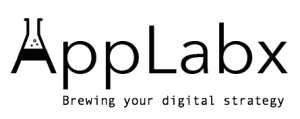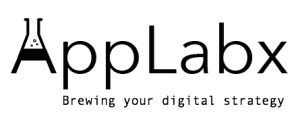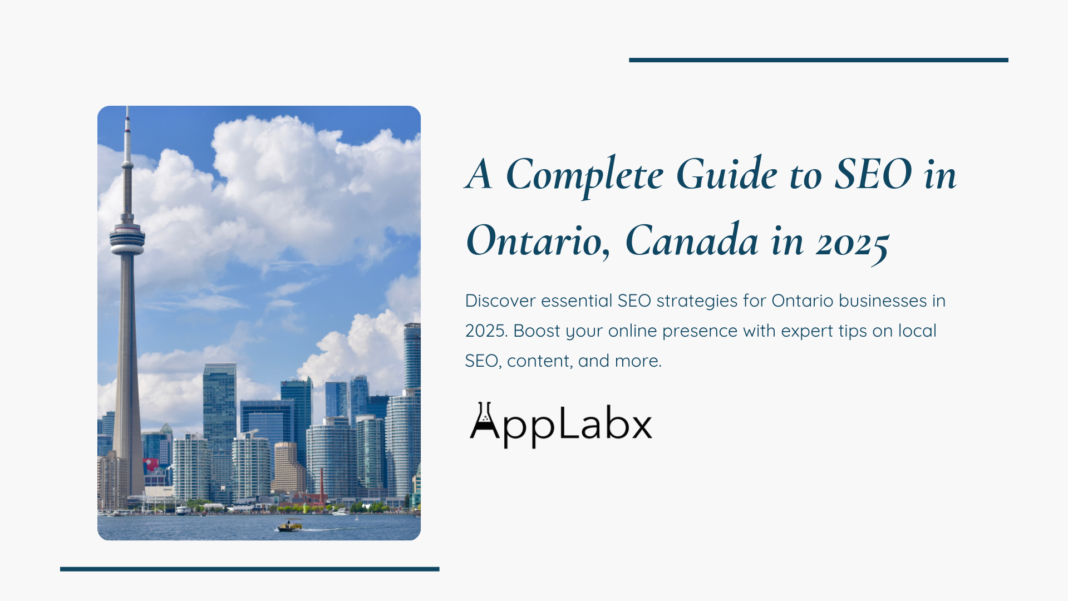Key Takeaways
- Stay ahead with local SEO strategies tailored to Ontario’s market, focusing on geo-targeted keywords and Google My Business optimization.
- Prioritize mobile-first design and Core Web Vitals to enhance user experience and improve search rankings in 2025.
- Leverage AI tools, content marketing, and quality backlinks to boost domain authority and ensure long-term SEO success in Ontario.
In today’s digital-first world, having a strong online presence is no longer optional for businesses in Ontario—it is a necessity.
Whether you run a local business in Toronto, a startup in Ottawa, or an established company in Mississauga, your ability to rank on search engines like Google can make or break your success.
As we enter 2025, SEO (Search Engine Optimization) is more dynamic than ever, driven by evolving algorithms, user behavior, and technological advancements.

This guide will explore everything you need to know about SEO in Ontario, Canada, in 2025—covering emerging trends, local SEO strategies, content marketing, technical optimization, and much more.
Whether you are a business owner, digital marketer, or SEO specialist, understanding how to adapt your strategies to meet the latest search engine requirements will be crucial to staying ahead of the competition.
Why SEO Matters for Businesses in Ontario
Ontario is the most populous province in Canada, home to major economic hubs such as Toronto, Ottawa, Hamilton, and London. With millions of people searching for products and services online, businesses that fail to optimize their websites risk losing out on significant traffic and potential revenue. Here’s why SEO is more important than ever:
1. Increased Online Competition
The digital marketplace is becoming more saturated, with businesses across all industries investing in online marketing. A well-structured SEO strategy helps you stand out from competitors and ensures your website ranks prominently when potential customers search for your offerings.
2. Shift in Consumer Search Behavior
With the rise of AI-driven search engines, voice search, and hyper-local queries, the way people search for information online is changing rapidly. Users now expect highly relevant, fast, and accurate search results tailored to their location and preferences.
3. Local SEO and Mobile Search Growth
Ontario-based businesses must focus on local SEO to attract nearby customers. Statistics show that a significant percentage of mobile users search for local services on their smartphones, and businesses that optimize for Google Business Profile, local citations, and hyper-local content are more likely to convert searchers into customers.
4. The Impact of Google Algorithm Updates
Search engines like Google are constantly refining their algorithms to improve the quality of search results. Businesses that fail to keep up with these changes may experience fluctuations in their rankings, leading to a drop in website traffic. Staying informed about SEO trends and algorithm updates is essential to maintaining online visibility.
Key SEO Trends Shaping Ontario’s Digital Landscape in 2025
To succeed in Ontario’s competitive digital market, businesses must stay ahead of the latest SEO trends. Some of the most influential factors shaping SEO in 2025 include:
1. AI-Powered Search & Machine Learning
Google’s AI algorithms, such as RankBrain and MUM (Multitask Unified Model), are becoming more sophisticated, understanding user intent more accurately than ever. Optimizing for semantic search, structured data, and user experience will be key to ranking higher.
2. Voice Search and Conversational Queries
With the widespread adoption of voice assistants like Siri, Alexa, and Google Assistant, more people are using voice search to find local businesses. Optimizing for natural language queries and long-tail keywords will be essential for improving visibility in voice search results.
3. Mobile-First Indexing and Core Web Vitals
Google continues to prioritize mobile-first indexing, meaning websites that are mobile-friendly and optimized for Core Web Vitals (loading speed, interactivity, and visual stability) will have an edge over competitors. Ensuring a seamless mobile experience is now a non-negotiable factor in SEO.
4. Video SEO and Visual Search Optimization
Platforms like YouTube, TikTok, and Instagram are influencing how people search for information. Businesses leveraging video content, image optimization, and structured video data will benefit from higher engagement and search rankings.
5. The Rise of Zero-Click Searches
More search queries are being answered directly on Google’s search results page through featured snippets, knowledge panels, and People Also Ask sections. To compete, businesses must optimize their content for rich snippets and structured data to gain visibility in zero-click searches.
How This Guide Will Help You Master SEO in Ontario
This comprehensive guide will walk you through the latest SEO strategies tailored for businesses in Ontario. You will learn:
- How to conduct Ontario-specific keyword research
- Best practices for on-page and off-page SEO in 2025
- The latest trends in local SEO and Google Business Profile optimization
- How to optimize content marketing and technical SEO for better rankings
- The role of AI, machine learning, and automation in modern SEO
- Key metrics and tools to track and measure SEO success
Whether you are looking to attract more local customers, drive organic traffic, or future-proof your website against algorithm changes, this guide provides actionable insights to help you stay ahead of the curve.
In the following sections, we will break down each aspect of SEO in Ontario, Canada, providing real-world examples, expert tips, and practical strategies to help you implement a winning SEO plan in 2025. Let’s dive in.
But, before we venture further, we like to share who we are and what we do.
About AppLabx
From developing a solid marketing plan to creating compelling content, optimizing for search engines, leveraging social media, and utilizing paid advertising, AppLabx offers a comprehensive suite of digital marketing services designed to drive growth and profitability for your business.
AppLabx is well known for helping companies and startups use SEO to drive web traffic to their websites and web apps.
At AppLabx, we understand that no two businesses are alike. That’s why we take a personalized approach to every project, working closely with our clients to understand their unique needs and goals, and developing customized strategies to help them achieve success.
If you need a digital consultation, then send in an inquiry here.
A Complete Guide to SEO in Ontario, Canada in 2025
- Understanding SEO in 2025
- Ontario-Specific SEO Factors
- On-Page SEO Best Practices in 2025
- Off-Page SEO Strategies for Ontario Businesses
- Technical SEO Essentials
- Local SEO: Dominating the Ontario Market
- Content Marketing & SEO in 2025
- Voice Search & AI in SEO
- Measuring and Tracking SEO Success
- SEO Regulations & Compliance in Canada
- Future-Proofing Your SEO Strategy in Ontario
1. Understanding SEO in 2025
Search Engine Optimization (SEO) is constantly evolving, and in 2025, businesses in Ontario need to adapt to the latest trends, algorithms, and consumer behaviors to maintain strong online visibility. Whether you are a local business in Toronto, a service provider in Ottawa, or an eCommerce brand catering to the entire province, understanding how SEO works in Ontario will be key to staying competitive.
This section covers how SEO has evolved, the impact of AI and machine learning, and the key differences between local and global SEO strategies that Ontario-based businesses should prioritize.
How SEO Has Evolved Over the Years
SEO is no longer just about adding keywords to content or building backlinks. The landscape has changed dramatically due to technological advancements, changing user behavior, and frequent algorithm updates by search engines like Google.
1. The Shift from Keyword-Driven SEO to Search Intent
- In the past, SEO focused heavily on keyword density—the number of times a keyword appeared in content.
- In 2025, Google prioritizes user intent over exact-match keywords, meaning businesses must understand the “why” behind searches rather than just focusing on specific terms.
- Example: Instead of targeting “best coffee shop Toronto,” businesses should also optimize for queries like “Where can I find organic coffee in Toronto?”
2. Rise of AI-Driven Search Algorithms
- Google’s AI-based algorithms, such as RankBrain and MUM (Multitask Unified Model), now analyze search intent more accurately than ever.
- Websites that offer valuable, well-structured content are favored over those relying on keyword stuffing.
- Example: A law firm in Ontario must create detailed legal guides and FAQs to address multiple aspects of a client’s query rather than just stuffing “best lawyer in Ontario” into a webpage.
3. Voice Search and Conversational Queries
- With voice assistants like Google Assistant, Siri, and Alexa, more users are searching through spoken queries rather than typed searches.
- Businesses must optimize content for natural language queries, as voice searches are usually longer and more conversational.
- Example: A bakery in Ottawa should target phrases like “Where can I buy gluten-free cupcakes near me?” instead of just “gluten-free cupcakes Ottawa.”
The Impact of AI and Machine Learning on Search Rankings
Artificial Intelligence (AI) and Machine Learning (ML) are reshaping SEO by making search engines more intuitive and user-focused. Google’s AI-driven ranking factors continue to evolve, making it essential for businesses to adapt their strategies accordingly.
1. Google’s AI-Powered Algorithms in 2025
- RankBrain: Understands context and user intent, rewarding pages that provide the most relevant answers.
- BERT & MUM: Helps Google interpret complex, multi-intent searches, making context-rich content essential for ranking.
- SpamBrain: Detects and penalizes spammy or low-quality sites, making ethical SEO practices more important than ever.
2. AI-Optimized Content and Personalized Search Results
- Search engines are now delivering hyper-personalized results, meaning two users searching for the same term may see different results based on:
- Search history and behavior
- Location and device type
- Previous engagement with websites
- Example: A user in Mississauga searching for “best restaurants” may see local dining options, while someone in Sudbury may get entirely different results based on location.
3. AI-Powered Chatbots and Virtual Assistants
- Businesses are increasingly using AI chatbots to improve customer engagement and lead generation.
- AI-driven chatbots can:
- Answer customer questions instantly, reducing bounce rates.
- Guide users to relevant content based on their queries.
- Improve user experience and boost SEO rankings by increasing dwell time.
Local SEO vs. Global SEO: What Ontario Businesses Need to Focus On
While global SEO aims to attract visitors from all over the world, local SEO is crucial for businesses targeting Ontario customers. Search engines prioritize local relevance, making it important to optimize for Ontario-specific searches.
1. Key Differences Between Local and Global SEO
| Factor | Local SEO (Ontario-Focused) | Global SEO |
|---|---|---|
| Target Audience | Users in specific Ontario cities or regions | Users from multiple countries or regions |
| Keywords | Geo-specific (e.g., “best hair salon in Brampton”) | Broad/global terms (e.g., “best hair care tips”) |
| Google Business Profile | Critical for ranking in local searches | Less important unless you have multiple locations |
| Content Focus | Location-based content (city guides, local news) | Industry trends, global case studies |
| Backlink Strategy | Ontario-based websites, directories, and citations | International links, high-authority domains |
2. How Ontario-Based Businesses Can Dominate Local SEO
- Claim & Optimize Google Business Profile
- Ensure NAP (Name, Address, Phone Number) consistency across all platforms.
- Encourage positive reviews from Ontario customers.
- Target Ontario-Specific Keywords
- Use terms like “best marketing agency in Toronto” instead of just “best marketing agency.”
- Research local slang and preferences for hyper-local targeting.
- Leverage Local Citations & Directories
- Get listed on Ontario business directories (e.g., YellowPages.ca, 411.ca).
- Secure citations from local newspapers and blogs (e.g., BlogTO, Ottawa Citizen).
- Create Ontario-Centric Content
- Write blog posts about Ontario events, laws, and industry trends.
- Example: A real estate agency in Ontario could create guides like “Buying a Home in Toronto: 2025 Market Trends.”
Conclusion
Understanding SEO in Ontario, Canada, in 2025 requires a deep knowledge of search engine evolution, AI-driven search trends, and the distinction between local and global SEO. Businesses that prioritize user intent, AI-driven strategies, and local SEO techniques will have a significant advantage over competitors.
As search engines become smarter and more personalized, Ontario businesses must shift from traditional keyword-based SEO to intent-driven, user-focused, and AI-optimized strategies. By focusing on local relevance, mobile-first experiences, and AI-powered engagement, businesses can improve their search rankings, attract more customers, and stay ahead in the ever-evolving digital landscape.
The next section will explore Ontario-Specific SEO Factors, diving deeper into regional keyword research, search behavior, and location-based search trends to help you tailor your SEO approach for success in 2025.
2. Ontario-Specific SEO Factors
Ontario is Canada’s most populous province, home to a wide range of businesses from local startups to multinational corporations. As the digital landscape evolves in 2025, businesses in Ontario need to focus on region-specific SEO strategies to effectively target their audience. This section will delve into the key Ontario-specific SEO factors, such as local search trends, regional keyword strategies, and the importance of location-based SEO practices.
By understanding how Ontario users search and optimizing for their unique behavior, businesses can increase their chances of ranking higher in local search results, driving more traffic to their websites and ultimately boosting their conversions.
Understanding Ontario’s Digital Landscape and Search Behavior
The search behavior of Ontarians is shaped by a variety of factors, including regional preferences, local trends, and the growing reliance on mobile devices. Knowing these preferences will enable businesses to fine-tune their SEO strategy for better visibility and engagement.
1. Regional Differences in Search Behavior
- Toronto: As Ontario’s largest city, Toronto has a diverse population with varied interests. Search queries here may be more competitive, with a focus on diverse industries, from technology to arts and culture.
- Example: A tech startup in Toronto might target keywords like “best digital marketing agency Toronto” or “top software development companies in Toronto.”
- Ottawa: As the political hub of Canada, Ottawa searches may center around government services, legal matters, and education.
- Example: A law firm in Ottawa should focus on keywords like “best immigration lawyer Ottawa” or “Ottawa family law expert.”
- Hamilton: Known for its industrial background, Hamilton businesses may target manufacturing, supply chain, and construction-related services.
- Example: A construction company in Hamilton could optimize for terms like “construction services Hamilton” or “best contractors in Hamilton.”
- Other Areas: Smaller Ontario towns like Sudbury, Kingston, and Windsor have different local interests, often focused on regional tourism, healthcare services, or niche businesses.
- Example: A tourism company in Niagara Falls could focus on terms like “Niagara Falls sightseeing tours” or “best hotels near Niagara Falls.”
2. Mobile and Voice Search Trends
- Mobile-first behavior: As more Ontarians use smartphones for search, mobile optimization becomes critical. Businesses must ensure that their websites are mobile-friendly to rank higher in Google’s mobile-first index.
- Example: A restaurant in Toronto should have a mobile-responsive website that allows users to easily browse the menu, read reviews, and place online orders from their smartphones.
- Voice search: With the growing use of voice assistants like Siri and Google Assistant, Ontarians are increasingly searching through conversational queries. Optimizing for long-tail keywords and natural language will help businesses target voice search users.
- Example: A plumbing service in Ottawa might optimize for phrases like “best plumbers near me in Ottawa” or “emergency plumbing services Ottawa.”
Ontario-Specific Keyword Research Strategies
Keywords are the foundation of SEO, and for businesses in Ontario, it is crucial to target both local and region-specific terms. Understanding the nuances of Ontario’s regional search preferences will help businesses create more targeted and relevant content that resonates with local users.
1. Localized Keyword Research
- Conduct keyword research using tools like Google Keyword Planner and Ahrefs to identify location-specific terms. Focus on keywords that reflect Ontario’s local businesses, services, and interests.
- Example: A real estate agent in Toronto may research terms like “homes for sale in Toronto” or “best neighborhoods in Toronto for families.”
- Use geo-modifiers such as “near me” or specific city names to capture localized search intent.
- Example: A home cleaning service in Brampton might target terms like “best home cleaning service Brampton” or “affordable cleaning companies near me in Brampton.”
2. Utilizing Local Long-Tail Keywords
- Ontarians often use more specific, detailed search phrases, especially when looking for services close to home. Optimizing for long-tail keywords can improve rankings in local search results.
- Example: A fitness center in Kitchener could target keywords like “best gym in Kitchener with personal training” or “affordable fitness classes Kitchener.”
- Long-tail keywords also help businesses capture intent-based searches, ensuring that your content answers the most relevant and pressing user needs.
3. Regional Slang and Terminology
- In Ontario, there may be variations in regional slang and local terminology that can affect search behavior. Incorporating local terms into your keyword strategy can boost SEO results.
- Example: A coffee shop in Ottawa could target keywords like “Ottawa best coffee shop for study sessions” or “cozy cafés in Ottawa.”
Optimizing for Location-Based Search Results
Local SEO is an integral part of any successful Ontario-based SEO strategy. Google’s algorithm heavily favors businesses that are well-optimized for local search, particularly when users perform location-based searches. Here’s how Ontario businesses can boost their local search rankings:
1. Google Business Profile Optimization
- Claim and optimize your Google Business Profile (formerly Google My Business). This is a crucial step for appearing in Google’s Local Pack and Google Maps search results.
- Ensure that all information, such as NAP (Name, Address, Phone Number), is accurate and consistent across your website and third-party directories.
- Example: A restaurant in Niagara Falls should ensure its Google Business Profile is updated with its correct location, hours, and menu options.
- Add high-quality photos and encourage reviews from Ontario-based customers. Positive reviews help improve local rankings and build trust with potential customers.
2. Local Citations and Directories
- List your business in Ontario-specific online directories such as 411.ca, YellowPages.ca, and NiagaraFallsTourism.com.
- Consistency is key: Ensure that your NAP information is consistent across all these directories to strengthen local SEO.
- Example: A spa in Kingston should have consistent mentions in both local tourism guides and online directories like Yelp or TripAdvisor.
3. Creating Ontario-Focused Content
- Develop content that specifically caters to Ontario’s audience, from local news and events to industry insights. Tailoring content to the unique interests of Ontarians can increase local engagement and boost SEO.
- Example: A financial advisor in Ontario could write blogs like “How Ontario’s New Tax Laws Affect Your Investments in 2025” or “Best Retirement Plans for Ontario Residents.”
- Incorporating local events or community initiatives can also enhance relevance and attract more local visitors.
- Example: A fitness studio in Hamilton could create content like “Top 10 Fitness Events in Hamilton this Summer” or “How to Stay Fit in Hamilton’s Winter Months.”
Leveraging Local Backlinks and Citations
Building high-quality, region-specific backlinks is another key component of Ontario-specific SEO. Links from reputable local websites help improve domain authority and relevance for local search queries.
1. Getting Backlinks from Local Websites
- Reach out to local news outlets, bloggers, and influencers for opportunities to earn backlinks. Ontario-based websites often have authority in local search results and can help elevate your SEO efforts.
- Example: A fashion retailer in Toronto could collaborate with a local fashion blogger to earn backlinks and drive traffic.
- Sponsor local events or initiatives and earn backlinks from their websites.
- Example: A tech company in Ottawa might sponsor a local coding bootcamp and get a backlink from the bootcamp’s website.
2. Local Mentions and Citations
- Gain visibility by participating in local forums or community events that discuss Ontario-related topics. Mentions in online discussions can boost credibility and SEO rankings.
- Example: A construction company in Windsor might get a mention in a local industry forum, such as Ontario Builder’s Association or Windsor Construction News.
Conclusion
Optimizing for Ontario-specific SEO factors in 2025 requires an in-depth understanding of regional user behavior, localized keywords, and location-based search strategies. By focusing on local SEO, geo-targeted content, and accurate online listings, businesses in Ontario can enhance their online visibility, attract more local traffic, and outperform competitors.
With the right approach, your business can dominate local search results, connect with Ontario-based customers, and build a strong online presence that fuels long-term success in a competitive digital landscape.
The next section will dive deeper into on-page SEO best practices for 2025, covering content optimization, user experience, and how to structure your site for maximum search engine performance.
3. On-Page SEO Best Practices in 2025
On-page SEO is a critical element for improving your website’s visibility in search engine results pages (SERPs). In 2025, the focus of on-page optimization is not just about integrating keywords but also enhancing user experience (UX), ensuring content relevance, and optimizing for AI-driven algorithms. Businesses in Ontario, Canada, need to align their on-page strategies with these changes to achieve the best possible search engine rankings.
This section explores the key on-page SEO best practices businesses in Ontario should focus on in 2025, such as content optimization, technical SEO elements, mobile optimization, and the integration of local SEO elements.
Content Optimization: Creating Valuable and Relevant Content
In 2025, content is still king, but its relevance, depth, and how it answers user intent have become even more important. Ontario businesses must focus on providing content that addresses user needs, incorporates local trends, and is aligned with search intent.
1. Focus on User Intent
- Search intent (whether informational, transactional, or navigational) is now a key ranking factor. In Ontario, businesses must align their content to match the user’s search purpose.
- Example: If a law firm in Toronto notices a spike in searches for “how to file for divorce in Ontario,” the content should answer that query in detail, discussing steps, legal requirements, and timelines specific to Ontario.
- Optimizing for long-tail keywords: Long-tail keywords help target users who are more likely to convert. These keywords should be highly specific and match the detailed queries of local users.
- Example: A plumber in Mississauga should target keywords like “affordable plumbing services in Mississauga” or “emergency plumbing repair Mississauga.”
2. Content Depth and Quality
- Google’s algorithms prioritize comprehensive content that thoroughly covers topics and provides detailed answers. For Ontario-based businesses, this means developing content that goes beyond surface-level information.
- Example: A health clinic in Ontario might create an extensive guide to “Ontario healthcare insurance options in 2025” or “How to choose the best healthcare provider in Ontario.”
- Use LSI (Latent Semantic Indexing) keywords, related terms, and synonyms to enhance the depth of content and increase its relevance to a broader set of search queries.
- Example: For a real estate business in Ontario, the content about “buying a home in Toronto” could include terms like “real estate market trends in Ontario,” “Toronto housing regulations,” or “mortgage advice for first-time homebuyers in Ontario.”
3. Localizing Content for Ontario Audiences
- Creating localized content that resonates with Ontario residents is crucial for improving rankings in local searches.
- Include references to Ontario landmarks, laws, events, and culture that make the content more relevant to local users.
- Example: A fitness center in Toronto could blog about “The Best Running Trails in Toronto” or “How to Stay Fit During a Toronto Winter.”
Technical On-Page SEO: Ensuring Your Site is Crawlable and Optimized
A technically sound website is necessary for ensuring that your content gets indexed and ranked by search engines. In 2025, technical SEO is about both search engine crawlers and user experience (UX). Businesses in Ontario should focus on optimizing the following technical elements:
1. Optimizing for Core Web Vitals
- Core Web Vitals are a set of user experience signals introduced by Google, which impact search rankings. These include metrics related to loading time, interactivity, and visual stability of a page.
- Largest Contentful Paint (LCP): Ensure that the largest visible content on your page (e.g., an image or main text block) loads within 2.5 seconds.
- First Input Delay (FID): This measures how long it takes for a page to become interactive. Aim for an FID of less than 100 milliseconds.
- Cumulative Layout Shift (CLS): Avoid unexpected shifts in the page layout during loading by making sure images, ads, and other dynamic elements are properly sized.
2. URL Structure and Internal Linking
- SEO-friendly URLs should be short, descriptive, and include relevant keywords. Ontario-based businesses should include location modifiers in their URLs.
- Example: A dentist in Ontario could use the URL “www.ontariodentist.com/services/teeth-whitening-toronto” instead of a generic one.
- Internal linking: Improve site navigation and help distribute page authority across your website by linking relevant pages together. Use anchor text that includes keywords.
- Example: A restaurant in Toronto could link its homepage to blog posts like “Best Lunch Specials in Toronto” or “Toronto’s Top Restaurants for Group Dining.”
3. Structured Data and Schema Markup
- Implement schema markup to help search engines better understand the content of your pages and display rich snippets in SERPs.
- Example: A hotel in Niagara Falls could implement schema for reviews, pricing, and availability, which can result in more visible search results and higher click-through rates.
- Use local business schema to mark up information about your business, such as address, phone number, hours of operation, and reviews.
- Example: A spa in Ontario could use local business schema to highlight their services, location, and user reviews.
Mobile Optimization: Ensuring a Seamless Mobile Experience
As mobile search continues to grow, businesses in Ontario must prioritize mobile optimization to provide a seamless user experience across devices. Google’s mobile-first indexing means that the mobile version of your website is considered the primary version when determining rankings.
1. Responsive Design and Fast Loading Times
- Ensure your website uses a responsive design that adjusts to various screen sizes, from mobile phones to tablets.
- Example: A retail store in Toronto should have a mobile-optimized shopping experience that includes easy navigation, fast-loading product pages, and smooth checkout.
- Page speed optimization is critical for mobile users, as they expect fast load times. Aim for loading speeds of under 3 seconds for mobile visitors.
- Use tools like Google PageSpeed Insights or GTmetrix to analyze and improve loading speeds.
- Example: A tech company in Ottawa could optimize images, minify code, and leverage browser caching to speed up mobile page loading.
2. Mobile-Friendly Navigation and User Experience
- Simplify mobile navigation to enhance usability on smaller screens. Avoid cluttered menus and ensure that call-to-action (CTA) buttons are easily clickable.
- Example: A gym in Mississauga might streamline its website navigation with dropdown menus that lead to sign-up pages, class schedules, and location info.
- Test your website regularly on different mobile devices to ensure that text is legible, buttons are easily clickable, and images display correctly.
Local SEO Elements: Fine-Tuning for Ontario Searches
Local SEO optimization is crucial for any Ontario-based business, and several on-page elements must be tailored to target Ontario residents effectively.
1. Title Tags and Meta Descriptions
- Title tags and meta descriptions should include both relevant keywords and location-specific modifiers to ensure your business ranks in local search results.
- Example: A florist in Toronto could optimize the title tag as “Fresh Flowers in Toronto | Best Florist in Ontario” and the meta description as “Order beautiful, fresh flowers from the top florist in Toronto, Ontario. Same-day delivery available.”
- Craft engaging meta descriptions that clearly describe your services while incorporating local terms to improve click-through rates.
2. Image Optimization for Local Search
- Optimize images by adding alt text that describes the image and includes relevant keywords, particularly location-based terms.
- Example: A museum in Ottawa could use alt text like “historical exhibit at the Ottawa Museum of Art” for images to rank for local art-related searches.
- Ensure that images are appropriately compressed to enhance page speed, especially for mobile users.
3. Local Landing Pages
- Create location-specific landing pages to target various regions across Ontario. Each page should be optimized with unique content, including local landmarks, events, or services specific to that region.
- Example: A plumbing service with multiple locations in Ontario could create separate pages for “Plumber in Toronto,” “Plumber in Ottawa,” and “Plumber in Mississauga” with tailored content for each city.
Conclusion
Implementing these on-page SEO best practices will significantly improve your search visibility and user experience in Ontario, Canada, in 2025. By focusing on high-quality content, technical optimization, mobile-friendliness, and local SEO elements, businesses can enhance their ranking on both local and national search results.
Incorporating these practices into your SEO strategy will not only help you attract more Ontario-based customers, but it will also align your website with the evolving search engine algorithms and user expectations, ensuring sustainable growth in the competitive digital market.
Next, we will explore off-page SEO tactics and how businesses can leverage backlinks, social media, and local citations to further boost their online authority.
4. Off-Page SEO Strategies for Ontario Businesses
Off-page SEO is a vital aspect of any comprehensive SEO strategy, particularly in 2025, when search engines emphasize authority, trustworthiness, and relevance. For Ontario businesses, off-page SEO strategies such as building backlinks, leveraging local citations, and engaging in social media can have a profound impact on search rankings and brand visibility.
In this section, we will cover the most effective off-page SEO strategies tailored to Ontario businesses, from acquiring high-quality backlinks to utilizing local directories and creating a strong social media presence.
Building High-Quality Backlinks: Enhancing Domain Authority
Backlinks are one of the most influential ranking factors in Google’s algorithm, and in 2025, quality trumps quantity. For Ontario-based businesses, it is crucial to focus on acquiring backlinks from relevant, authoritative, and local sources to boost domain authority and improve organic rankings.
1. Earned Backlinks from Local Media Outlets
- Ontario businesses should target local media outlets, including newspapers, radio stations, and television networks, for backlinks. Getting featured in these outlets will not only increase visibility but also build trust with local audiences.
- Example: A restaurant in Toronto could pitch a local food blogger or news outlet for a feature or review, which would generate quality backlinks.
- Local outlets like The Toronto Star, Ottawa Citizen, and CBC Ontario are trusted sources where backlinks can significantly boost domain authority.
- Example: A local tech startup might get featured in a tech column on a prominent Ontario-based site, linking back to their website.
2. Industry-Specific and Niche Backlinks
- Focus on acquiring backlinks from industry-relevant websites or organizations within Ontario to improve your site’s authority. Links from authoritative, niche sites are highly valued by search engines.
- Example: A construction company in Hamilton might seek backlinks from industry groups such as the Ontario Construction Association or local trade magazines.
- Target association memberships and industry partnerships to earn backlinks from trusted business associations in Ontario.
- Example: A financial advisor in Ontario might earn backlinks from Ontario’s Financial Services Regulatory Authority or local financial blogs.
3. Guest Blogging on Local Platforms
- Contribute high-quality guest posts on local websites and blogs in your industry. Not only do guest posts allow you to showcase your expertise, but they are also an excellent source of relevant backlinks.
- Example: A real estate agent in Toronto could contribute an article to Toronto Life or a local real estate blog, which would include a backlink to their website.
- Make sure the blog post is well-written and provides valuable insights to the local audience, increasing the likelihood of backlinks being earned.
Leveraging Local Citations and Online Directories
Citations are another essential off-page SEO strategy, especially for Ontario businesses aiming to rank in local search results. Citations are online mentions of your business information (Name, Address, Phone Number, and Website), typically found in business directories and local listings. These references signal credibility to search engines and are a crucial part of local SEO.
1. Claiming and Optimizing Local Listings
- Ontario businesses should ensure they are listed in local business directories and online platforms such as Yellow Pages, 411.ca, and Canada411. Consistent NAP (Name, Address, Phone Number) details across these platforms help establish local relevance and authority.
- Example: A plumber in Ottawa should ensure their listing is accurate on Yelp, Google My Business, and Ontario-based review sites like HomeStars.
- Keep all details updated across directories to avoid issues with inconsistent information that could hurt your SEO performance.
2. Using Niche-Specific Directories
- In addition to general business directories, focus on niche-specific directories for your industry. Many industries in Ontario have specialized directories that can boost your authority in that niche.
- Example: A law firm in Ontario might be listed on the Law Society of Ontario directory, and a healthcare service provider could focus on platforms like Healthgrades Canada or RateMDs for local citations.
- Local municipal websites and tourism boards often list businesses as well. Getting listed in these directories will not only help local rankings but will also provide exposure to relevant audiences.
- Example: A tourism company in Niagara Falls should be listed on the Niagara Falls Tourism website for increased visibility and credibility.
3. Managing and Encouraging Online Reviews
- Online reviews are an important off-page ranking factor. Positive reviews from satisfied customers on Google My Business, Yelp, and Trustpilot help build trust and authority.
- Encourage customers to leave positive reviews by providing excellent service and sending follow-up emails with links to your review pages.
- Example: A spa in Mississauga could ask clients to leave feedback on their Google My Business profile or Yelp page after a service.
- Responding to reviews—especially negative ones—shows engagement and customer care, which can improve the reputation of your business and influence potential customers’ decisions.
Engaging on Social Media: Building Brand Awareness
In 2025, social media plays a major role in increasing brand awareness, driving traffic, and indirectly improving SEO. While social media signals themselves may not directly affect rankings, a strong social media presence helps businesses gain visibility, increase brand mentions, and engage with customers, all of which contribute to overall SEO performance.
1. Build a Strong Social Media Presence
- Create business profiles on major social media platforms such as Facebook, Instagram, LinkedIn, Twitter, and TikTok. Ontario businesses can leverage these platforms to connect with local customers and create content tailored to the Ontario audience.
- Example: A local Ontario bakery can share images of their latest baked goods and interact with customers by responding to comments or running local promotions.
- Post locally relevant content, such as promotions, community involvement, and partnerships with Ontario-based organizations.
- Example: A local fitness center in Toronto might post about hosting fitness events in the city or collaborating with local influencers to promote healthy living.
2. Collaborate with Ontario Influencers
- Work with local influencers who have a significant following in Ontario to increase brand exposure. Influencer collaborations can drive traffic to your website and social media pages, providing indirect SEO benefits.
- Example: A Toronto fashion retailer might collaborate with fashion bloggers or Instagram influencers who focus on Ontario-based fashion to review their products.
- When collaborating with influencers, ensure they link back to your website and provide valuable mentions, ideally leading to increased website traffic and backlinks.
3. Create Shareable Content and Build Social Signals
- Develop engaging content that encourages social sharing, such as videos, blog posts, infographics, and interactive content. When local users share your content, it boosts brand visibility and may lead to backlinks.
- Example: A Toronto-based tech company could share innovative product demos or blog posts related to the Ontario tech industry that are shared by local tech enthusiasts on social media.
- Regularly post about local events, news, and topics that resonate with your Ontario audience. Content that taps into local interests and cultural trends is more likely to be shared, thereby creating more social signals.
Local Community Involvement and Sponsorships
An often overlooked off-page SEO strategy is local community involvement. Ontario businesses can gain visibility, build trust, and earn backlinks through local partnerships, sponsorships, and events.
1. Sponsoring Local Events or Charities
- Participate in community events or sponsor local causes to gain backlinks and exposure. Many local events have websites or blogs that feature their sponsors, providing valuable backlinking opportunities.
- Example: A construction company in Ottawa might sponsor a local charity event and receive backlinks from the event’s website, which increases local SEO value.
- Sponsoring sports teams, local festivals, or cultural events allows businesses to align with the community, earning recognition while promoting their brand.
2. Collaborating with Local Schools and Universities
- Ontario businesses can partner with local universities, schools, or educational institutions to create internships, workshops, or student projects, which can help create backlinks and social media mentions.
- Example: A marketing firm in Toronto might collaborate with Ryerson University’s business program and receive backlinks from their student projects or academic pages.
- These partnerships provide opportunities for educational blog posts or other content that will naturally link back to your website.
Conclusion
Off-page SEO is a critical part of achieving long-term online success in 2025. For Ontario businesses, a focus on building high-quality backlinks, leveraging local citations, engaging with the community, and building a strong social media presence can enhance both search rankings and brand authority.
By implementing these strategies, businesses can increase local visibility, improve brand credibility, and build a solid online reputation—all of which contribute to achieving higher rankings in competitive Ontario search markets.
In the final section of this guide, we will discuss how to measure and track the success of your SEO efforts using analytics and key performance indicators (KPIs) that matter for businesses in Ontario.
5. Technical SEO Essentials
Technical SEO is a crucial aspect of improving a website’s visibility, user experience, and overall performance. In 2025, the search engine algorithms prioritize fast loading times, mobile-friendliness, secure websites, and the use of structured data. For Ontario businesses, mastering technical SEO is not only about aligning with these requirements but also about optimizing their website to ensure smooth navigation, fast page loads, and seamless interaction with search engines.
This section delves into the key technical SEO essentials that Ontario businesses should focus on in 2025 to stay competitive and maintain strong rankings in search engine results pages (SERPs).
Mobile Optimization: A Critical Factor for SEO in Ontario
Mobile optimization has become one of the most significant factors in ranking websites. Google’s mobile-first indexing means that the mobile version of your website is used for crawling and indexing. Businesses in Ontario must focus on responsive design, page speed, and mobile user experience (UX) to ensure a smooth experience across all devices.
1. Mobile-First Indexing
- Mobile-first indexing means that Google predominantly uses the mobile version of your website for ranking purposes. This means that Ontario businesses should prioritize mobile optimization when designing or updating their websites.
- Example: A local fitness center in Toronto should ensure its website is responsive and delivers an engaging mobile experience, with easily accessible class schedules, membership information, and contact details.
- If your website’s mobile version is difficult to navigate or offers a poor user experience, it may significantly impact your rankings and bounce rates.
2. Implementing a Responsive Design
- A responsive design ensures that your website adapts to different screen sizes, including smartphones, tablets, and desktops.
- Example: A restaurant in Mississauga must have a website that offers easy online reservations, a mobile menu, and contact details without requiring zooming or horizontal scrolling.
- CSS media queries and fluid grids allow for better layout adjustments and responsive elements across devices.
3. Optimizing Mobile Speed
- Mobile users are highly sensitive to loading speeds. A slow mobile website can increase bounce rates and decrease conversions.
- Optimize images: Compress and use next-gen formats like WebP for faster load times.
- Leverage browser caching: This allows repeated visitors to access your site faster by saving static resources on their devices.
- Minimize JavaScript and CSS: Reducing unnecessary code and optimizing scripts can significantly speed up mobile page loading times.
- Example: A local clothing store in Toronto should aim for fast mobile page load times, especially during sale seasons, as slow loading may result in lost sales.
Page Speed Optimization: Enhancing User Experience
Page speed is a critical ranking factor, particularly for businesses in Ontario looking to attract both local and national customers. A fast-loading website provides a better user experience, increases engagement, and improves rankings.
1. Google Core Web Vitals
- Google’s Core Web Vitals are a set of user experience signals that measure how users interact with a webpage. These metrics include Largest Contentful Paint (LCP), First Input Delay (FID), and Cumulative Layout Shift (CLS).
- Largest Contentful Paint (LCP): LCP measures how long it takes for the largest visible element (such as an image or video) on the page to load. Aim for an LCP of under 2.5 seconds.
- First Input Delay (FID): FID measures the time it takes for a page to become interactive. Aim for an FID of under 100 milliseconds.
- Cumulative Layout Shift (CLS): CLS measures unexpected layout shifts during page load. A CLS score of less than 0.1 is ideal.
- Example: An Ontario-based e-commerce store should optimize images and use lazy loading to ensure fast content loading, improving both LCP and FID.
2. Image Optimization
- Large image files can significantly slow down page load times. To improve speed, Ontario businesses should:
- Resize images: Ensure images are no larger than necessary.
- Compress images: Use tools like TinyPNG or ImageOptim to reduce image sizes without compromising quality.
- Use responsive images: Use the srcset attribute to serve different images based on the user’s device.
- Example: A photography business in Toronto should optimize portfolio images to ensure they load quickly on both mobile and desktop without compromising visual quality.
3. Minifying CSS, JavaScript, and HTML
- Minification is the process of removing unnecessary characters from CSS, JavaScript, and HTML files without affecting functionality.
- Minify CSS/JS: Tools like UglifyJS and CSSNano can help reduce the size of your website’s code.
- Remove unused code: Tools like PurgeCSS help identify and remove unused styles and scripts from your site.
- Example: A digital marketing agency in Ontario can reduce the size of its website’s code by removing unnecessary styles and scripts, thereby improving the page load time.
Secure Your Website: HTTPS and SSL Certificates
Website security is paramount for both user trust and SEO. Google has confirmed that HTTPS is a ranking factor, and users are increasingly wary of sites that don’t provide secure connections.
1. Implement HTTPS
- HTTPS (HyperText Transfer Protocol Secure) ensures that data transferred between the website and users is encrypted, securing sensitive information.
- Google prioritizes websites that use HTTPS in its search rankings.
- Example: A financial advisory firm in Ontario should have HTTPS encryption in place to instill confidence in clients handling sensitive financial data.
2. Obtain and Install an SSL Certificate
- SSL (Secure Sockets Layer) certificates are essential for HTTPS. Ontario businesses must purchase and install an SSL certificate from a trusted provider.
- SSL certificates can be obtained through hosting services or platforms like Let’s Encrypt (free option).
- Example: An online clothing retailer should ensure that their checkout process is secure with an SSL certificate, making customers feel safe when entering payment details.
Structured Data: Enhancing Rich Snippets
Structured data, or schema markup, is an important technical SEO practice that helps search engines understand your website’s content. It can also enhance your search listings by enabling rich snippets, which increase click-through rates (CTR).
1. Implement Schema Markup for Local SEO
- Ontario businesses must implement local business schema markup to help search engines recognize important business details like your name, address, phone number, reviews, and hours of operation.
- This can increase your chances of appearing in Google’s Local Pack and help your website stand out in local search results.
- Example: A restaurant in Ottawa can add restaurant schema to show hours of operation, menu, and customer reviews directly in search results.
2. Rich Snippets and FAQ Schema
- Adding FAQ schema allows your website to show frequently asked questions directly in search results. This is a great way to increase visibility and attract traffic.
- Example: A local law firm in Ontario could include FAQ schema for common legal questions like “What is the process for filing a personal injury claim in Ontario?”
- Additionally, businesses can use product schema to display prices, reviews, and availability, which enhances the display of e-commerce products in search results.
XML Sitemap and Robots.txt: Optimizing Crawlability
An XML sitemap is a critical technical SEO component that helps search engines discover and index your website’s pages more efficiently. Additionally, the robots.txt file plays a role in controlling which pages search engines can crawl.
1. Create and Submit an XML Sitemap
- Ensure your website has an updated XML sitemap that lists all pages you want search engines to crawl. This will help search engines understand the structure of your site and discover all relevant pages.
- Example: A real estate business in Ontario could create an XML sitemap that includes property listings, blogs, and market reports to ensure search engines index all available content.
- Submit your XML sitemap to Google Search Console and Bing Webmaster Tools to ensure search engines can easily access it.
2. Optimize Robots.txt
- Use the robots.txt file to manage which pages search engines can crawl and index. For example, you can prevent crawlers from indexing duplicate content or unnecessary pages like admin or login pages.
- Example: An online store in Ontario might use robots.txt to block search engines from crawling the “Thank You” page after a user completes a purchase, ensuring only valuable pages are indexed.
Conclusion
Technical SEO is a foundational element for improving a website’s search rankings and user experience. In 2025, Ontario businesses need to ensure their websites are mobile-friendly, secure, fast, and structured with the appropriate data. By following the technical SEO best practices outlined in this section—such as optimizing for page speed, securing the site with HTTPS, implementing structured data, and ensuring proper crawlability—businesses can build a strong foundation for long-term SEO success.
With the growing emphasis on user experience and technical signals, mastering these technical aspects of SEO will ensure that Ontario businesses remain competitive and continue to thrive in the ever-evolving digital landscape.
6. Local SEO: Dominating the Ontario Market
Local SEO is essential for businesses aiming to attract customers within specific geographical areas. In 2025, with the increasing reliance on mobile searches and voice search, optimizing for local search is more critical than ever, particularly for businesses operating in Ontario. Effective local SEO helps businesses stand out in local search results, drive more foot traffic to their physical locations, and generate higher-quality leads.
This section will explore the most effective strategies for dominating the Ontario market through local SEO in 2025, from optimizing your Google My Business profile to utilizing local citations, building local backlinks, and ensuring your website is designed for local search success.
Google My Business Optimization for Ontario Businesses
One of the most powerful local SEO tools available is Google My Business (GMB). It enables Ontario businesses to control how they appear on Google Search and Maps, increasing visibility in local search results.
1. Claim and Verify Your Google My Business Listing
- The first step is to claim and verify your GMB profile. A verified GMB listing not only boosts local visibility but also helps businesses appear in the Local Pack and Google Maps.
- Example: A dentist in Toronto can claim their GMB listing, ensuring their clinic shows up when someone searches for “dentist near me” or “best dentist in Toronto.”
- Ensure that your NAP (Name, Address, Phone Number) is consistent with your website and other local directories to avoid confusing search engines and users.
2. Complete Your Google My Business Profile
- Fill out every section of your GMB profile, including business hours, services offered, and images. This information enhances your listing’s relevance and trustworthiness.
- Example: A Toronto-based bakery should list their opening hours, services (e.g., custom cakes, catering), and upload high-quality photos of their products, creating a more engaging profile.
- Add detailed descriptions of your business and services, ensuring that relevant keywords related to your industry and location are included.
- Example: A local HVAC company in Ontario can write a description that includes keywords like “air conditioning repair in Ontario,” helping them rank for local service searches.
3. Regularly Update Your Google My Business Profile
- Keep your business hours up to date, especially around holidays or special events. This shows Google that your business is active and relevant.
- Example: A local restaurant in Ottawa should update their hours and promotions for holiday seasons to ensure customers can easily find their opening times.
- Respond promptly to customer reviews and questions on GMB. Positive reviews increase trust and engagement, while responding to questions demonstrates excellent customer service.
Optimizing for Local Keywords
Choosing the right local keywords is crucial for Ontario businesses looking to rank well in search engines. These keywords should reflect the specific services or products you offer and target the geographical area you serve.
1. Include Location-Specific Keywords
- Use keywords that incorporate your city or region to increase your chances of appearing in local search results.
- Example: A plumber in Brampton should use terms like “emergency plumbing in Brampton” or “affordable plumber in Brampton” to target customers in that area.
- For broader regional targeting, include provincial terms like “Ontario,” “GTA (Greater Toronto Area),” or the names of local neighborhoods in your content.
- Example: A personal injury lawyer in Ontario might target keywords like “best personal injury lawyer Ontario” or “Ontario accident lawyer.”
2. Leverage Long-Tail Local Keywords
- Long-tail keywords are specific search phrases that often have less competition and higher conversion rates. These keywords should include location, service, and other specific details.
- Example: A Toronto-based real estate agent might target long-tail keywords such as “luxury homes for sale in Toronto” or “best real estate agent in downtown Toronto.”
- Use tools like Google Keyword Planner, Ahrefs, or SEMrush to discover keywords that are most relevant to your Ontario-based business and audience.
3. Focus on Voice Search Optimization
- Voice search is becoming increasingly popular, and many voice queries are location-based. Ensure that your website and GMB profile are optimized for natural language queries.
- Example: A local coffee shop in Kingston should optimize for queries like “Where is the best coffee in Kingston?” or “Nearby coffee shop open now.”
- Use conversational keywords and questions in your content to better align with how people use voice search.
Local Citations and Directory Listings
Local citations are references to your business on external websites and local directories. These citations help improve local relevance and trustworthiness in search engines. For Ontario businesses, having consistent NAP (Name, Address, Phone Number) data across local directories and citation sources is critical.
1. Submit Your Business to Local Directories
- Ensure that your business is listed in popular local directories such as Yellow Pages, 411.ca, and Yelp. These directories are commonly used by people searching for local services in Ontario.
- Example: A chiropractor in Toronto should list their practice on Yelp, Yellow Pages, and CanadianBusinessDirectory.com for enhanced visibility.
- Consider industry-specific directories as well. A local lawyer might benefit from listing in legal directories such as CanadianLaws.com or LawSociety.ca.
2. Ensure NAP Consistency
- Consistency in your NAP across all local citations is essential for local SEO. Discrepancies in your NAP can confuse search engines and hurt your local rankings.
- Example: A car repair shop in Ottawa should ensure that their phone number, address, and business name are exactly the same across all directories and citation sites.
3. Get Listed on Local Business Networks
- Joining local business organizations and networking groups can provide additional citation opportunities. Chamber of Commerce or local business alliances often list member businesses on their websites, which can lead to high-quality backlinks.
- Example: A construction company in Ontario could join the Ontario Home Builders’ Association and get listed in their directory, further enhancing its local SEO profile.
Building Local Backlinks
Backlinks are one of the most important ranking factors for SEO, and local backlinks are particularly valuable for businesses looking to dominate the Ontario market.
1. Partner with Local Influencers and Bloggers
- Local influencers, bloggers, and journalists can provide high-quality backlinks and increase your online visibility.
- Example: A fashion boutique in Toronto can collaborate with local fashion bloggers to review their products and provide backlinks to the boutique’s website.
- Look for opportunities to work with Ontario-based influencers who have a strong following in your target market.
2. Sponsor Local Events and Causes
- Sponsoring local events or charities often results in backlinks from event websites and news articles, which increases your local SEO.
- Example: A local tech startup in Ottawa could sponsor a tech conference and receive backlinks from the event’s website, social media, and local news coverage.
- Sponsorships demonstrate a commitment to the local community, which can improve both your brand image and SEO.
3. Build Relationships with Local Media
- Engaging with local media outlets and getting featured in newspapers, magazines, or news websites can provide authoritative backlinks.
- Example: A restaurant in Kingston might get featured in a local food critic’s column, earning a high-quality backlink to their website.
- Media mentions not only improve SEO but also help increase brand awareness within the local community.
Local Content Marketing and Blogging
Content marketing tailored to local interests and concerns can help your business rank higher in local search results. Publishing content that addresses the needs of your Ontario audience demonstrates local expertise and increases engagement.
1. Create Location-Specific Blog Posts
- Writing about local events, industry trends, and Ontario-specific topics can help businesses rank for local search queries.
- Example: A local gym in Toronto might write a blog post on “The Best Places to Run in Toronto” or “How to Stay Fit in Toronto’s Winter Months.”
- Feature local news and business events in your blog posts to further resonate with your audience.
2. Highlight Customer Stories and Testimonials
- Local customer testimonials and case studies can improve local relevance and show that your business is engaged with the community.
- Example: A Toronto-based cleaning service might post a customer testimonial from a local client who discusses how the company helped them with spring cleaning in their Toronto home.
- Showcase success stories from local clients in blog posts to build credibility and trust within your target market.
3. Optimize for Local Search Intent
- Craft content around local search intent by answering common questions related to your industry and region. Use keywords that directly reflect local user intent.
- Example: A plumbing service in Ottawa can create content answering questions like “How to Fix a Leaky Faucet in Ottawa Winter” or “Top Plumbing Tips for Ottawa Homeowners.”
Conclusion
Dominating the Ontario market through local SEO in 2025 requires a focused and comprehensive strategy. By optimizing your Google My Business profile, leveraging local keywords, building local citations and backlinks, and engaging in local content marketing, Ontario businesses can significantly improve their visibility in local search results.
The key to success is not just optimizing for Google but creating an online presence that aligns with the needs and interests of your local customers. In a competitive landscape, businesses that focus on community engagement, hyper-local content, and building local authority will have the best chances of standing out in Ontario’s search results.
7. Content Marketing & SEO in 2025
In 2025, content marketing and SEO continue to be interlinked and indispensable for businesses looking to thrive online, especially in competitive markets like Ontario. Businesses in Ontario must create high-quality, locally relevant content that not only appeals to their target audience but also follows best SEO practices to ensure it ranks well on search engines. Content that educates, entertains, and engages the local audience builds trust, drives organic traffic, and ultimately leads to higher conversion rates.
This section explores how content marketing in Ontario should be optimized for SEO in 2025. It covers strategies to create valuable content, utilize local SEO tactics, and optimize for both users and search engines, while keeping up with the latest content trends that will dominate the Ontario market.
Creating High-Quality, SEO-Friendly Content for Ontario Audiences
Producing high-quality content that resonates with local Ontario consumers is a crucial factor in boosting SEO. Content must answer specific user queries, provide value, and integrate relevant local keywords for maximum visibility in search engines.
1. Understand Your Audience and Create Targeted Content
- Start by understanding the needs, pain points, and interests of your Ontario-based audience. This will help you create content that aligns with their search intent and needs.
- Example: A home renovation business in Ontario can create blog posts and guides about the specific types of renovations popular in the region, such as basement finishing in Toronto or energy-efficient home upgrades in Ottawa.
- Consider segmenting your audience by demographics, interests, and locality to develop content that appeals to specific groups in Ontario.
- Example: A fitness center in Mississauga may create content targeting different age groups, such as “Best Fitness Programs for Seniors in Mississauga” or “Top Workouts for Busy Professionals in Mississauga.”
2. Focus on Localized Content
- In Ontario, businesses must tailor their content to reflect local issues, trends, and news. Content that speaks to the concerns or interests of a specific region can increase relevance and engagement.
- Example: A Toronto-based coffee shop can blog about local events, festivals, and food trends in Toronto, such as “Top 5 Toronto Coffee Festivals You Should Visit in 2025” or “Sustainable Coffee Practices in Toronto’s Growing Coffee Scene.”
- Creating location-specific content with mentions of Ontario neighborhoods, landmarks, or trends can improve rankings in local searches.
- Example: A landscaping business in Brampton can write content like “Best Landscaping Ideas for Small Gardens in Brampton” to target local property owners looking for services.
Optimizing Content for Local SEO in Ontario
While high-quality content is essential, it needs to be optimized for local search to ensure it ranks well in Ontario’s competitive SEO landscape. Local SEO focuses on improving visibility in geographically relevant searches.
1. Use Local Keywords Strategically
- Ensure your content includes location-specific keywords, such as city names, neighborhoods, or regions within Ontario.
- Example: A tax service provider in Windsor should focus on keywords like “tax services in Windsor” or “affordable tax filing in Windsor” to capture search intent from local users.
- Incorporate long-tail local keywords that are highly specific and less competitive. These keywords typically generate higher-quality leads.
- Example: A family lawyer in Hamilton might target long-tail keywords like “divorce lawyer Hamilton with child custody expertise” or “affordable family lawyers in Hamilton.”
2. Add Local Data and Statistics to Your Content
- By incorporating local statistics and data points, you provide more valuable and credible content that appeals to your audience’s needs and interests.
- Example: A real estate agent in Niagara could include insights such as “Average home prices in Niagara in 2025” or “How to buy a house in Niagara during a competitive market.”
- Research local market trends, demographics, or cultural aspects of the Ontario region to create content that is highly relevant and informative to residents and businesses in specific cities or towns.
3. Optimize for Google My Business and Local Search Features
- Ensure your content is aligned with the information on your Google My Business (GMB) profile to provide a consistent and coherent experience to local searchers.
- Example: If you run a cleaning service in Ottawa, make sure your GMB profile and content include relevant keywords like “Ottawa cleaning services” or “professional cleaners in Ottawa.”
- Use location-based schema markup on your website to help Google understand the geographic focus of your content, improving its chances of ranking in local search results.
Utilizing Video and Visual Content for Ontario SEO
In 2025, visual content, particularly videos and infographics, are more important than ever for SEO. Video content can increase engagement, boost conversion rates, and improve the user experience. For businesses in Ontario, incorporating video marketing into your SEO strategy can be a game-changer.
1. Create Localized Video Content
- Video content is highly engaging and can rank in both Google and YouTube search results. Creating local videos tailored to your target Ontario audience helps establish your authority and relevance.
- Example: A local restaurant in Ottawa could create a video on “The Best Dishes to Try at [Restaurant Name] in Ottawa” or a local yoga studio in Ontario might produce “10-Minute Yoga Routine for Busy Ontarians.”
- Make sure your videos feature Ontario locations or local landmarks to enhance relevance to local viewers.
2. Optimize Video Content for SEO
- Ensure that your video titles, descriptions, and tags are optimized with relevant local keywords. For instance, a moving company in Ontario can upload videos like “How to Move to Ontario – Tips and Tricks for First-Time Movers” and optimize it with terms like “moving services in Ontario.”
- Include transcriptions and captions to make videos more accessible and indexable by search engines, further boosting SEO.
3. Use Infographics and Visual Content
- Infographics are great for breaking down complex topics into digestible and shareable visual content. Incorporate local data or trends in your infographics to appeal to the Ontario audience.
- Example: A digital marketing agency in Toronto can create an infographic on “The Importance of SEO for Ontario Businesses” or “SEO Trends to Watch in 2025 for Toronto Businesses.”
- Infographics and other visual assets can be shared on social media, driving traffic and increasing backlinks to your site, further improving your SEO.
Content Distribution Channels for Ontario Businesses
Effective content marketing goes beyond creation; it involves strategic distribution to ensure that your content reaches the right audience. For Ontario-based businesses, distributing content through the right channels is crucial for SEO success.
1. Leverage Social Media for Content Distribution
- Social media platforms are excellent tools for distributing content, increasing its reach, and attracting local customers.
- Example: A local coffee shop in Toronto might promote blog posts about the best coffee spots in the city on Instagram and Facebook, creating local engagement and traffic.
- Ensure your social media posts are optimized with local hashtags and location tags to increase discoverability by Ontario-based users.
- Example: A Toronto-based fitness influencer can share a workout video using hashtags like #TorontoFitness, #TorontoGym, or #OntarioHealth.
2. Engage in Local Online Communities
- Participating in local online communities like Reddit’s Toronto or Ontario threads, Facebook groups, and local forums is an effective way to distribute content and engage with potential customers.
- Example: A home decor store in Hamilton can join local Facebook groups where people exchange tips and ideas about home improvement and share useful blog posts about decor trends in Ontario.
- Consider creating content specifically tailored for these communities to increase the chances of your posts being shared and commented on, boosting both traffic and SEO.
3. Build Email Lists for Content Promotion
- Email marketing remains one of the best methods to reach customers directly with new content. Create a segmented email list based on your Ontario audience to send localized content updates, offers, and relevant blog posts.
- Example: A Toronto-based fashion boutique can send targeted emails promoting new arrivals or offering exclusive discounts to subscribers in Toronto, increasing engagement and traffic to the website.
- Regularly send newsletters or content that highlights Ontario-based trends, events, or news to keep your audience engaged and encourage them to share your content.
Measuring and Tracking Content Marketing Success in Ontario
To ensure your content marketing efforts are delivering results, it’s important to measure and track key metrics. Analytics help businesses understand which content is performing well and which areas need improvement.
1. Use Google Analytics to Track Local Traffic
- Use Google Analytics to monitor local traffic to your website, track user behavior, and identify which pieces of content are driving the most engagement.
- Example: A local travel agency in Ontario could use Google Analytics to see which content about Ontario tourist destinations is generating the most local traffic.
2. Monitor Local Search Rankings
- Keep track of how well your content is ranking for targeted local keywords using SEO tools such as Ahrefs, SEMrush, or Moz.
- Example: A local pet store in Ottawa could track keyword rankings like “pet supplies Ottawa” or “dog grooming services in Ottawa” to assess how well their content is performing in local searches.
3. Measure Engagement and Conversions
- Track metrics like bounce rate, time on page, conversion rates, and social shares to gauge how engaging and effective your content is.
- Example: A local boutique in Ontario could measure conversions from a blog post about fashion trends and analyze whether those readers are completing a purchase.
Conclusion
Content marketing and SEO in Ontario in 2025 go hand-in-hand, requiring businesses to create high-quality, localized content that resonates with the target audience and is optimized for search engines. By utilizing local SEO strategies, producing engaging videos and visuals, and distributing content through the right channels, Ontario businesses can achieve greater visibility and success in a competitive online marketplace. Ultimately, combining valuable content with effective SEO practices is the key to driving traffic, increasing brand authority, and ensuring sustainable growth in Ontario’s evolving digital landscape.
8. Voice Search & AI in SEO
As voice search and artificial intelligence (AI) continue to evolve, businesses in Ontario must adapt their SEO strategies to stay competitive. With the increasing use of smart speakers, virtual assistants, and AI-powered search engines, optimizing for voice search has become a critical component of any effective SEO strategy. These technologies change how consumers interact with search engines, placing more emphasis on conversational queries, local results, and AI-driven content.
This section will explore how businesses in Ontario can leverage voice search and AI technologies to improve their SEO efforts in 2025, providing practical insights and relevant examples.
The Rise of Voice Search in Ontario
Voice search has gained significant traction over the past few years, driven by the popularity of smart devices like Amazon Alexa, Google Assistant, and Siri. In Ontario, voice search adoption is particularly high in urban areas like Toronto, Ottawa, and Hamilton, where busy professionals and tech-savvy consumers rely on voice commands to search for information hands-free.
1. Understanding Voice Search Behavior in Ontario
- Voice search queries tend to be more conversational and question-based compared to traditional text searches. Users often ask complete questions rather than typing in short keywords.
- Example: A local coffee shop in Toronto might see voice search queries like “Where can I find the best coffee near me in Toronto?” instead of just typing “best coffee Toronto.”
- Consumers in Ontario are increasingly using voice search for local and immediate needs, such as finding nearby businesses, checking weather conditions, or getting directions.
- Example: A plumbing business in Ottawa might receive voice search queries like “Emergency plumbing services near me in Ottawa.”
2. Optimizing for Voice Search in Ontario
- Businesses must adapt their SEO strategies to cater to voice search, which typically involves long-tail keywords and natural language.
- Example: A fitness center in Mississauga could optimize content around voice search queries like “Best gym for weight loss near me in Mississauga.”
- Focus on creating FAQ-style content that answers common questions consumers might ask through voice search.
- Example: A local bakery in Kingston could have a FAQ page optimized for queries like “What are the best gluten-free options at a bakery in Kingston?”
3. The Importance of Local SEO for Voice Search
- Voice search is heavily reliant on local results, so it’s important to ensure your business is well-optimized for local SEO in Ontario.
- Claim and optimize your Google My Business (GMB) listing to improve visibility in voice search results.
- Example: A dentist in Burlington should ensure their GMB profile is fully optimized with relevant business details, location, and local keywords to rank higher for local voice queries.
- Ensure your business is listed in local directories and map applications, as these platforms often provide voice search results.
AI and Machine Learning in SEO for Ontario Businesses
Artificial intelligence and machine learning are reshaping the SEO landscape, helping businesses in Ontario optimize their digital presence more effectively. AI algorithms like Google’s BERT and RankBrain use natural language processing to interpret search queries, providing more relevant results.
1. The Impact of AI on Search Algorithms
- In 2025, AI-powered search engines will continue to evolve, making it essential for businesses to stay ahead of changes in search algorithms.
- Google’s BERT (Bidirectional Encoder Representations from Transformers) and RankBrain are AI algorithms that help Google understand the context and intent behind search queries, rather than just focusing on keywords.
- Example: A local tour guide in Niagara Falls could benefit from optimized content that addresses a user’s intent, such as “What to do in Niagara Falls in 2025” instead of simply targeting keywords like “Niagara Falls tours.”
2. Content Creation with AI Assistance
- AI is transforming content creation by helping businesses create high-quality, relevant content at scale. Tools like GPT-3, Jasper, and Writesonic can assist Ontario businesses in generating content that resonates with both users and search engines.
- Example: A restaurant in Ottawa could use AI-powered tools to generate engaging blog posts on local food trends or recipes tailored to customer preferences.
- AI-driven content tools can also help businesses improve the structure and readability of their content, ensuring that it meets the latest SEO standards.
- Example: A legal service provider in Toronto can use AI to craft well-organized, informative content on specific legal topics, optimizing it for both local SEO and user experience.
3. AI-Powered Chatbots and Customer Interactions
- AI-powered chatbots are increasingly becoming an integral part of customer service and engagement, improving user experience and providing instant responses to customer queries. These chatbots also help enhance SEO by increasing user engagement metrics like time on site and decreasing bounce rates.
- Example: A fashion store in Ontario could use an AI chatbot to help customers find the right outfits based on their preferences, answering questions like “What are the latest trends in Ontario for winter fashion in 2025?”
- By integrating AI-driven chatbots with structured data and local SEO, businesses can improve visibility in search engine results pages (SERPs) and drive more targeted traffic.
Optimizing for Voice Search and AI with Conversational Content
To optimize for voice search and AI, businesses in Ontario should focus on creating content that mirrors the way people speak and ask questions. This approach helps capture long-tail keywords and improves rankings for both voice and traditional search.
1. Conversational Keyword Research
- Focus on long-tail, question-based keywords that people use in voice searches. Use tools like Answer the Public or Google’s People Also Ask to identify relevant queries.
- Example: A local plumber in Hamilton might target voice search queries like “How do I fix a leaky pipe in Hamilton?” or “What’s the cost of plumbing services in Hamilton?”
- Analyze Google’s People Also Ask and autocomplete suggestions for common voice search questions.
- Example: A dog grooming service in Toronto could target phrases like “Where can I find the best dog groomers in Toronto?”
2. Structured Data and Featured Snippets
- Implement structured data (Schema Markup) to provide clear, organized information to AI and search engines, which can be used to enhance voice search results.
- Example: A wedding planner in Ottawa could mark up their content with structured data to increase the chances of their business appearing in a featured snippet for queries like “Best wedding venues in Ottawa.”
- Structured data helps search engines identify important content, such as operating hours, locations, services, and FAQ sections, which are often read aloud in voice search results.
3. Writing for Voice Search Optimization
- When creating content for voice search, write in a natural, conversational tone that mirrors how people speak in daily life. Avoid overly technical or formal language and focus on answering questions clearly.
- Example: A local home improvement company in Ontario could create content like “How long does it take to renovate a kitchen in Ontario?” or “What are the most popular kitchen renovations in Ontario?”
- Ensure your content answers questions directly, as voice search queries often expect quick and straightforward answers.
- Example: A local yoga studio in Toronto could answer “What’s the best yoga studio near me in Toronto?” in a concise, informative manner.
The Role of AI in Predicting SEO Trends in Ontario
AI is also revolutionizing SEO by predicting trends and offering insights that can help Ontario businesses stay ahead of the competition.
1. AI-Powered Trend Analysis
- AI tools can help businesses predict search trends, consumer behavior, and market shifts, allowing them to adjust their content and SEO strategies accordingly.
- Example: An Ontario-based e-commerce store might use AI-powered tools to forecast the best-selling products for the upcoming season and adjust content accordingly, optimizing for specific keywords.
- By analyzing historical data, AI can help businesses predict the evolution of local consumer interests and tailor content to emerging trends in Ontario.
2. AI for Personalized Content Delivery
- AI allows businesses to deliver highly personalized content to their users, increasing engagement and conversions. Personalized content is increasingly important as consumers in Ontario expect more tailored experiences.
- Example: A local real estate agent in Toronto could use AI to show prospective buyers listings based on their browsing history, increasing the chances of conversions.
Conclusion
The integration of voice search and AI into SEO practices is no longer optional for Ontario businesses—it is essential for staying competitive in 2025. Voice search, with its focus on conversational queries and local results, requires businesses to adjust their content and SEO strategies. AI, on the other hand, offers valuable tools for optimizing content, analyzing trends, and improving user experience. By optimizing for both voice search and AI, businesses in Ontario can enhance their visibility, improve user engagement, and future-proof their digital presence.
9. Measuring and Tracking SEO Success
To ensure that your SEO efforts are delivering the expected results, it’s crucial for businesses in Ontario to consistently measure and track their SEO performance. In 2025, SEO metrics go beyond just tracking website traffic and keyword rankings. With evolving SEO strategies, businesses must incorporate advanced tools, techniques, and performance indicators to get a clear picture of their SEO success. This section will explore the essential metrics, tools, and strategies for measuring SEO success in Ontario in 2025, providing businesses with the right approach to evaluate and refine their efforts.
Key SEO Metrics to Track in Ontario in 2025
Tracking the right metrics is crucial for assessing the effectiveness of SEO strategies. The following are key performance indicators (KPIs) that businesses in Ontario should focus on to measure SEO success:
1. Organic Traffic
- Why it matters: Organic traffic represents the number of visitors coming to your website from unpaid search results, making it one of the most direct indicators of SEO performance.
- Example: A local law firm in Ottawa can track an increase in organic traffic as a result of optimizing their website for specific legal terms related to Ontario law.
- What to track:
- The number of organic visits over time
- Changes in the volume of organic traffic after SEO changes
- Traffic segmentation based on location, device, and demographics
- Tools:
- Google Analytics and Google Search Console help track organic traffic and provide detailed insights into user behavior.
2. Keyword Rankings and Visibility
- Why it matters: Keyword rankings are fundamental to SEO. Monitoring your keyword positions helps you understand how well your website ranks for target search queries.
- Example: A plumbing business in Hamilton that targets keywords like “emergency plumbing services in Hamilton” should track its position for this term to ensure it ranks on the first page of search results.
- What to track:
- Rankings for targeted keywords
- Tracking rankings for long-tail keywords that match voice search queries
- Keyword visibility in local search results
- Tools:
- Ahrefs, SEMrush, and Moz are popular tools for keyword tracking and competitive analysis.
3. Click-Through Rate (CTR)
- Why it matters: CTR measures the percentage of people who click on your website link when it appears in search results. A high CTR indicates that your title tags and meta descriptions are compelling enough to drive traffic.
- Example: A real estate agent in Toronto might notice that their CTR improves after optimizing their meta descriptions to include location-specific keywords like “best Toronto real estate agent.”
- What to track:
- The CTR for organic search results
- CTR for specific keywords or pages
- Changes in CTR after SEO adjustments (e.g., updating meta tags)
- Tools:
- Google Search Console offers detailed data on CTR for search queries and individual pages.
4. Bounce Rate
- Why it matters: The bounce rate represents the percentage of visitors who leave your site after viewing only one page. A high bounce rate may indicate that the page doesn’t fulfill user intent or that the content is irrelevant.
- Example: A local restaurant in Ontario might see a high bounce rate if their homepage doesn’t provide immediate access to their menu, making it harder for visitors to find the information they want.
- What to track:
- Bounce rate by landing page and traffic source
- Pages with the highest bounce rates (indicating where improvements are needed)
- Tools:
- Google Analytics can help identify pages with high bounce rates and assess their performance.
5. Conversion Rate
- Why it matters: Conversion rate measures the percentage of visitors who complete a desired action on your site, such as making a purchase, filling out a contact form, or subscribing to a newsletter.
- Example: A local car dealership in Ontario may track conversion rates for users who schedule test drives or contact the dealership for more information.
- What to track:
- Conversion rate for key actions on the site (e.g., contact form submissions, purchases)
- Changes in conversion rates after implementing SEO improvements
- Tools:
- Google Analytics and HubSpot can track conversions and provide insights into user behavior.
Essential SEO Tools for Tracking Success in Ontario
Utilizing the right SEO tools is essential for gathering accurate data and making informed decisions. Below are some of the most effective tools for tracking SEO success in Ontario in 2025:
1. Google Analytics
- Purpose: Tracks overall website performance, including traffic sources, user behavior, and conversions.
- Key Features:
- Provides data on organic traffic and landing page performance
- Allows segmentation by location, device, and traffic source
- Tracks bounce rate, time on site, and other engagement metrics
- Key Features:
- Why it’s valuable: Essential for understanding how users interact with your site, including those arriving from organic search.
2. Google Search Console
- Purpose: Offers in-depth insights into website performance in Google search results.
- Key Features:
- Tracks keyword rankings and search queries that lead to your site
- Monitors site health with core web vitals, mobile usability, and crawl errors
- Provides data on CTR, impressions, and average position
- Key Features:
- Why it’s valuable: Offers direct insight into how Google views your website and provides critical data for optimizing SEO performance.
3. SEMrush
- Purpose: A comprehensive SEO tool for keyword research, competitor analysis, and performance tracking.
- Key Features:
- Tracks keyword rankings and backlinks
- Provides in-depth competitor analysis to identify opportunities
- Offers local SEO tracking and audit features
- Key Features:
- Why it’s valuable: Ideal for businesses that want to track their performance compared to competitors and uncover new keyword opportunities.
4. Ahrefs
- Purpose: A tool for backlink analysis, keyword tracking, and content analysis.
- Key Features:
- Tracks organic traffic and keyword rankings
- Provides link-building opportunities and backlink data
- Offers site audit features to identify technical SEO issues
- Key Features:
- Why it’s valuable: Essential for improving site authority and tracking backlinks, which are crucial for SEO success.
Understanding User Engagement Metrics
User engagement metrics provide valuable insights into how visitors are interacting with your website, which can influence SEO performance. These metrics are particularly important for businesses looking to improve their content and user experience in Ontario.
1. Average Session Duration
- Why it matters: Measures how long visitors stay on your site. Longer sessions often indicate that visitors find the content valuable and engaging.
- Example: A tourism website in Ontario can track whether users spend more time reading detailed guides on local attractions, indicating high engagement with content.
- What to track:
- Average session duration for pages with targeted keywords
- Pages with the highest average session durations
- Tools:
- Google Analytics offers insights into session duration and how it changes over time.
2. Pages Per Session
- Why it matters: Indicates how many pages users view during a single visit to your site. More pages per session suggest that users are exploring your content more deeply.
- Example: A real estate agent in Ontario may see an increase in pages per session if they offer informative content about buying homes in specific regions of Ontario.
- What to track:
- Pages per session for top-performing content
- Changes in pages per session after SEO optimization (e.g., adding internal links)
- Tools:
- Google Analytics can provide detailed data on pages per session.
The Role of A/B Testing in Tracking SEO Success
A/B testing helps businesses compare the performance of two variations of a webpage to determine which one performs better in terms of key metrics like CTR, conversion rates, and engagement.
1. Implementing A/B Tests for SEO
- Test title tags, meta descriptions, and call-to-action (CTA) buttons to determine which versions drive more clicks or conversions.
- Example: A fashion retailer in Ontario might run an A/B test comparing two versions of a product page with different titles to see which one leads to more purchases.
- A/B testing can also be applied to landing pages to refine user experience and improve SEO results.
2. Tools for A/B Testing
- Google Optimize and Optimizely are popular A/B testing tools that help businesses test changes to their web pages, measure performance, and adjust strategies accordingly.
Conclusion
Measuring and tracking SEO success in Ontario in 2025 requires a comprehensive approach, leveraging a combination of key metrics, advanced SEO tools, and user engagement indicators. Businesses must consistently monitor organic traffic, keyword rankings, CTR, and conversion rates to assess the effectiveness of their SEO strategies. Additionally, leveraging tools like Google Analytics, SEMrush, and Ahrefs can provide invaluable insights into SEO performance, while A/B testing allows businesses to refine their content and user experience. By keeping track of these metrics and making data-driven adjustments, Ontario businesses can achieve long-term SEO success.
10. SEO Regulations & Compliance in Canada
As the digital landscape evolves, businesses in Ontario, Canada, must stay abreast of SEO regulations and compliance requirements to avoid penalties and ensure they are adhering to ethical marketing practices. In 2025, compliance with privacy laws, content regulations, and accessibility standards has become increasingly important for SEO strategies. Failing to comply with these regulations can lead to a loss of rankings, reduced website traffic, and even legal consequences. This section will explore the key SEO regulations and compliance considerations for Ontario businesses in 2025, highlighting the most important guidelines and providing actionable steps for adherence.
1. Data Privacy and Protection Regulations in 2025
With the rise of online data collection, privacy regulations have become a significant concern for businesses operating in Ontario. These regulations ensure that personal data collected from users is protected and that consumers have control over their data. Key privacy regulations that impact SEO strategies include:
1.1 General Data Protection Regulation (GDPR)
- What it is: The GDPR is a European Union (EU) regulation that impacts businesses worldwide if they collect or process the personal data of EU residents.
- Example: If an Ontario-based e-commerce store sells products to EU customers, it must comply with GDPR, including obtaining explicit consent to collect customer data.
- Key Requirements:
- Obtaining clear consent for data collection
- Providing transparency on how customer data will be used
- Allowing users to access, correct, or delete their personal data
- How it impacts SEO:
- Data privacy issues may affect your website’s trustworthiness and reputation.
- Google and other search engines value trustworthiness, so failure to comply with GDPR can result in lower search rankings.
1.2 Personal Information Protection and Electronic Documents Act (PIPEDA)
- What it is: PIPEDA is Canada’s federal privacy law that governs how businesses collect, use, and disclose personal data in the course of commercial activities.
- Example: An Ontario-based law firm must comply with PIPEDA when collecting personal data from clients, including using this data for marketing or customer relationship management.
- Key Requirements:
- Clear consent for data collection
- A written privacy policy outlining data practices
- The ability to delete or modify personal data upon request
- How it impacts SEO:
- Ensuring compliance with PIPEDA can build trust with users, positively influencing brand reputation, and boosting user engagement, indirectly impacting SEO.
1.3 California Consumer Privacy Act (CCPA)
- What it is: Although it primarily applies to businesses in California, the CCPA affects any company that deals with the personal data of California residents, including Ontario businesses with California-based customers.
- Example: An Ontario-based online retailer who ships to California must comply with CCPA when collecting customer information, including details of purchases and behavior on the website.
- Key Requirements:
- Inform users of their data collection practices
- Provide options for users to opt-out of data selling
- Allow users to request information about the data collected about them
- How it impacts SEO:
- Non-compliance with the CCPA can result in penalties and decreased user trust, negatively affecting your brand’s SEO performance.
2. Content Regulations and Ethical SEO Practices
In 2025, content regulations and the ethical guidelines surrounding SEO have become more defined. Google and other search engines have cracked down on websites using manipulative or deceitful tactics to gain rankings. Ethical SEO practices are not just about ranking well but also ensuring compliance with content regulations.
2.1 Google’s E-A-T (Expertise, Authoritativeness, Trustworthiness) Guidelines
- What it is: Google’s E-A-T guidelines determine how content is evaluated for quality and relevance. Pages that meet E-A-T criteria are more likely to rank higher.
- Example: A healthcare provider in Ontario must ensure that their content, such as blog posts or advice columns, is written by verified experts in the field of healthcare.
- Key Requirements:
- Expertise in the content being created
- Authoritativeness backed by credentials and reliable sources
- Trustworthiness, especially for content related to health, finance, and legal topics
- How it impacts SEO:
- Poor adherence to E-A-T standards can result in lower rankings for pages, especially those related to sensitive topics like health, law, and finance.
2.2 Copyright and Intellectual Property Compliance
- What it is: Copyright laws govern how content is used, ensuring that businesses don’t infringe on others’ intellectual property. This includes written content, images, videos, and logos.
- Example: An Ontario-based photographer who uses stock images must ensure those images are licensed properly for use on their website to avoid copyright violations.
- Key Requirements:
- Obtaining permission for third-party content usage
- Properly attributing content when necessary
- Ensuring that all images and videos are royalty-free or licensed
- How it impacts SEO:
- Copyright violations can result in penalties, the removal of content, or legal action, damaging your SEO performance and online reputation.
2.3 Avoiding Black-Hat SEO Practices
- What it is: Black-hat SEO refers to unethical practices used to manipulate search rankings, such as keyword stuffing, cloaking, and link farming.
- Example: An Ontario-based digital marketing agency caught engaging in link farming to artificially boost client websites will see their clients’ rankings drop, potentially resulting in penalties.
- Key Requirements:
- Following ethical SEO practices, including creating high-quality content and gaining organic backlinks
- Avoiding keyword stuffing or hidden text to manipulate search engine results
- How it impacts SEO:
- Search engines, especially Google, penalize websites using black-hat SEO, which can result in significant drops in rankings or complete removal from search results.
3. Accessibility Regulations in SEO
Web accessibility is an essential factor for SEO compliance in 2025, especially as search engines aim to provide better user experiences for people with disabilities. Ensuring your website meets accessibility standards is not only a legal requirement but also beneficial for SEO.
3.1 WCAG 2.1 (Web Content Accessibility Guidelines)
- What it is: WCAG 2.1 provides guidelines on how to make digital content more accessible to people with disabilities. Websites that adhere to these guidelines are better optimized for search engines and can reach a broader audience.
- Example: An Ontario-based retail business must ensure that its website’s images have alt-text for visually impaired users, improving both accessibility and SEO performance.
- Key Requirements:
- Providing alternative text for images
- Ensuring that videos have captions or transcripts
- Creating content that is navigable using a keyboard
- How it impacts SEO:
- Websites that comply with accessibility standards are favored by search engines, increasing visibility and potentially boosting rankings.
3.2 Ontario Human Rights Code
- What it is: The Ontario Human Rights Code requires that businesses ensure their websites are accessible to all individuals, including those with disabilities. Non-compliance can result in legal actions and reputational damage.
- Example: A law firm in Ontario must ensure their website complies with accessibility guidelines, ensuring equal access to legal information for all visitors.
- Key Requirements:
- Accessibility features such as screen reader compatibility and color contrast for visually impaired users
- Providing accessible content in multiple formats (e.g., large print or braille)
- How it impacts SEO:
- Accessibility compliance can enhance user experience, which search engines prioritize, indirectly influencing SEO performance.
4. Mobile-First Indexing Compliance
Mobile-first indexing means that Google uses the mobile version of a website as the primary version for indexing and ranking. In 2025, mobile optimization is not just a best practice; it is a necessity for SEO compliance.
4.1 Google’s Mobile-First Indexing
- What it is: Google now primarily uses the mobile version of websites to rank and index pages, so a mobile-friendly website is crucial for SEO success.
- Example: An Ontario-based restaurant must ensure their mobile website is easy to navigate, loads quickly, and displays key information such as menus and contact details effectively on mobile devices.
- Key Requirements:
- Mobile-friendly design with fast page load speeds
- Responsive web design to ensure seamless experience on various devices
- Optimized images and content for mobile devices
- How it impacts SEO:
- Non-compliance with mobile-first indexing can lead to poor rankings, particularly for mobile searches, which make up a significant portion of web traffic.
Conclusion
SEO regulations and compliance in 2025 are multifaceted, involving data privacy laws, ethical content creation, accessibility standards, and mobile optimization. Ontario businesses must remain vigilant in adhering to privacy laws like GDPR, PIPEDA, and CCPA, follow Google’s E-A-T guidelines, avoid black-hat SEO techniques, and ensure that their websites are accessible and mobile-friendly. By aligning SEO strategies with these regulations, businesses not only avoid penalties but also build a trustworthy, user-friendly online presence that attracts more organic traffic and boosts long-term SEO success.
11. Future-Proofing Your SEO Strategy in Ontario
As SEO continues to evolve, businesses in Ontario must not only adapt to current trends but also anticipate changes that will shape the digital landscape in the coming years. Future-proofing your SEO strategy ensures that your business remains competitive and visible in the search engine results pages (SERPs), even as algorithms, user behavior, and technological advancements change. In this section, we will explore actionable strategies and considerations for future-proofing your SEO efforts in Ontario in 2025, with a focus on emerging trends, tools, and long-term tactics.
1. Staying Ahead of Algorithm Changes
Search engines, particularly Google, frequently update their algorithms to improve the quality of search results. To future-proof your SEO strategy, it is essential to stay ahead of these changes and continuously optimize your website according to the latest SEO guidelines.
1.1 Monitoring Google Algorithm Updates
- What it is: Google’s algorithms undergo frequent updates, which can significantly impact search rankings. Major updates like Core Web Vitals and the Helpful Content update have reshaped SEO priorities in recent years.
- Example: A local business in Ontario that specializes in custom furniture may experience significant ranking fluctuations if they do not keep up with changes related to user experience or content quality.
- Key Strategies:
- Follow SEO news and updates through reliable sources like Google’s official Search Central Blog and reputable SEO blogs like Moz or Search Engine Journal.
- Keep track of Core Web Vitals, as page experience signals become increasingly important for ranking.
- Regularly audit your website to ensure it aligns with Google’s quality guidelines.
- How it impacts SEO:
- Proactively adjusting your SEO strategy in response to algorithm updates minimizes the risk of sudden ranking drops and keeps your website aligned with current best practices.
1.2 Preparing for AI and Machine Learning in SEO
- What it is: Google’s use of artificial intelligence (AI), including machine learning technologies like RankBrain and BERT, is continuously evolving. These systems aim to better understand search queries and user intent, which influences ranking decisions.
- Example: An Ontario-based tech company must optimize its content to align with AI-driven search results, focusing on natural language processing (NLP) to improve its visibility for a wider range of related queries.
- Key Strategies:
- Focus on high-quality, conversational content that aligns with AI’s understanding of search intent.
- Implement structured data (schema markup) to help search engines understand your content context better.
- Optimize for semantic search, ensuring your content addresses related topics, not just primary keywords.
- How it impacts SEO:
- AI is increasingly responsible for how websites are ranked, so optimizing your website for AI’s understanding of content can give you an edge over competitors and help maintain rankings as AI evolves.
2. Embracing Mobile Optimization
Mobile-first indexing has been a priority for Google for several years, and this trend will continue to dominate in 2025. Businesses in Ontario must ensure their websites are optimized for mobile users to stay competitive in the search results.
2.1 Implementing Mobile-First Design
- What it is: Google primarily uses the mobile version of a website for indexing and ranking. As mobile usage continues to grow, having a mobile-first design is essential for SEO success.
- Example: An Ontario-based real estate agency must have a fully responsive website design that allows potential buyers to easily search properties and view listings on mobile devices.
- Key Strategies:
- Use responsive design techniques that automatically adjust content and layout based on screen size.
- Prioritize fast load times on mobile by compressing images and utilizing caching mechanisms.
- Ensure easy navigation and legible text on mobile devices without requiring zooming.
- How it impacts SEO:
- Websites that provide seamless mobile experiences are favored by Google, leading to higher rankings and improved user engagement.
2.2 Optimizing for Voice Search
- What it is: With the increasing use of voice assistants like Google Assistant, Siri, and Alexa, optimizing for voice search is becoming essential for businesses in Ontario. Voice queries tend to be longer and more conversational, requiring a different SEO approach.
- Example: A local restaurant in Ontario may see a boost in local traffic if their website is optimized to answer voice queries like “What time does Joe’s Pizza open today?”
- Key Strategies:
- Focus on long-tail keywords and natural language to match how people speak when using voice search.
- Optimize for local searches by including location-based keywords and ensuring your Google My Business profile is complete and accurate.
- Use FAQ sections on your website to address common voice search queries.
- How it impacts SEO:
- Optimizing for voice search helps businesses capture traffic from voice-activated devices, providing a competitive advantage in the local market.
3. Focusing on User Experience (UX) and Core Web Vitals
Google’s Core Web Vitals, which focus on user experience signals, will continue to be an essential ranking factor in 2025. By improving user experience on your website, you can significantly impact your rankings and reduce bounce rates.
3.1 Core Web Vitals and Page Experience
- What it is: Core Web Vitals are a set of metrics that evaluate page loading performance, interactivity, and visual stability. Websites that provide a superior user experience are more likely to rank higher.
- Example: A e-commerce website in Ontario that prioritizes fast page load times and ensures smooth, interactive browsing will have a higher chance of ranking well, especially on mobile devices.
- Key Strategies:
- Optimize images and videos for faster loading times.
- Implement lazy loading to delay the loading of off-screen content until it is needed.
- Focus on eliminating elements that cause visual instability, such as shifting content when a page loads.
- How it impacts SEO:
- Improving Core Web Vitals will directly influence your rankings, as Google places a heavy emphasis on page experience for both mobile and desktop users.
3.2 Ensuring Accessibility Compliance
- What it is: Website accessibility ensures that users, including those with disabilities, can easily access and navigate your site. Accessibility features also play a role in SEO by improving user experience and reaching a wider audience.
- Example: An Ontario-based financial services company that ensures their website is accessible to individuals with visual impairments will benefit from increased trust, user engagement, and SEO.
- Key Strategies:
- Implement accessibility best practices such as providing text alternatives for images and using proper heading structures.
- Test website accessibility regularly to ensure it complies with WCAG (Web Content Accessibility Guidelines).
- Make your website keyboard-friendly for users with motor impairments.
- How it impacts SEO:
- Accessible websites often see higher user retention and lower bounce rates, which are positive signals for SEO.
4. Leveraging Artificial Intelligence and Automation Tools
AI and automation are transforming SEO by helping businesses streamline their efforts and make data-driven decisions. To future-proof your strategy, Ontario businesses should integrate AI tools and automation into their SEO processes.
4.1 Utilizing AI for Content Creation
- What it is: AI tools, such as natural language generation (NLG) software, can assist in creating high-quality content that resonates with your audience and ranks well in search engines.
- Example: An Ontario-based tech startup may use AI to automatically generate technical blog posts or product descriptions, saving time while still producing SEO-optimized content.
- Key Strategies:
- Use AI tools to identify trending topics and generate content ideas based on user queries and search intent.
- Incorporate AI-generated content into your SEO strategy to improve content production efficiency.
- Ensure that AI-generated content maintains quality and relevance to avoid penalties for thin or irrelevant content.
- How it impacts SEO:
- AI tools can help you stay ahead of the content demand curve, enabling faster content production and improved SEO performance.
4.2 Automating SEO Audits and Reporting
- What it is: SEO audits and performance reporting are essential for tracking and optimizing your SEO efforts. Automation tools can simplify this process by providing real-time insights into your website’s SEO health.
- Example: An Ontario-based digital marketing agency can use automated SEO audit tools to monitor keyword rankings, page speed, and backlinks without manual intervention.
- Key Strategies:
- Implement tools like SEMrush, Ahrefs, or Moz to automatically track keyword rankings and site health.
- Use reporting tools like Google Analytics or Data Studio to automate performance reports for ongoing SEO analysis.
- How it impacts SEO:
- Automation reduces the time spent on manual tasks, allowing you to focus on strategy while ensuring your website’s SEO health is continuously monitored.
5. Building Long-Term Link Building and Authority
Building domain authority and acquiring high-quality backlinks will continue to be essential for ranking higher on search engines in 2025. Future-proofing your SEO strategy involves implementing sustainable link-building practices that contribute to long-term success.
5.1 Focus on High-Quality Backlinks
- What it is: Backlinks from authoritative, relevant websites signal to search engines that your website is credible. Building these high-quality backlinks is a key part of future-proofing your SEO.
- Example: A Ontario-based software company can earn backlinks from tech blogs or universities, improving their domain authority and search engine rankings.
- Key Strategies:
- Develop relationships with authoritative websites in your niche and collaborate on content, guest posts, or case studies.
- Focus on acquiring links from industry-specific directories, media outlets, and influencers.
- Avoid black-hat tactics like link farms and paid backlinks.
- How it impacts SEO:
- High-quality backlinks contribute significantly to ranking improvements and long-term SEO stability.
Conclusion
Future-proofing your SEO strategy in Ontario in 2025 requires a forward-thinking approach that incorporates the latest trends, tools, and best practices. By staying ahead of algorithm changes, optimizing for mobile-first indexing, embracing AI-driven content creation, and prioritizing user experience, businesses can ensure long-term SEO success. Additionally, by focusing on sustainable link-building efforts and compliance with privacy and accessibility regulations, Ontario businesses can maintain a competitive edge and continue to perform well in search engine rankings for years to come.
Conclusion
As we move into 2025, SEO in Ontario, Canada, presents a dynamic and ever-evolving landscape for businesses to navigate. Whether you are a local business aiming to attract customers in your city, or a broader enterprise striving to expand your online reach, understanding the local nuances, the latest SEO trends, and the tools available will be crucial for long-term success. From on-page SEO to technical optimization, content marketing to local SEO strategies, and everything in between, there is no single solution for mastering SEO. Instead, it is about consistently adapting and staying ahead of emerging trends while continuing to focus on delivering high-quality, valuable content to users.
This complete guide has provided a comprehensive overview of the key components of SEO in Ontario in 2025, but the true success of your SEO strategy lies in how well you can integrate these insights into your ongoing marketing efforts. Below are some final takeaways to keep in mind as you refine your SEO strategy for the coming year.
1. Adaptation and Continuous Learning
SEO is not a static process; it is a constantly evolving field. Google’s algorithm updates, changing user behavior, and new technological advancements demand that businesses in Ontario remain adaptable and proactive in their SEO strategies. The companies that succeed in the long term are those that invest in continuous learning, staying updated on industry trends, and testing new tactics.
- Keep an eye on Google’s algorithm updates, focusing on changes related to Core Web Vitals, mobile optimization, and AI-driven search results.
- Experiment with new techniques and monitor their impact on rankings, adjusting as necessary to ensure that your strategy is always in line with what search engines value most.
- Consider investing in professional SEO tools and analytics platforms to help track the effectiveness of your efforts and identify areas for improvement.
2. The Importance of Local SEO in Ontario
For businesses operating in Ontario, local SEO remains one of the most critical aspects of any digital marketing strategy. Ontario’s diverse economy and urban landscapes mean that local businesses must employ location-specific tactics to stand out in search engine results. Whether you are a small café in Toronto or a manufacturing company in Hamilton, local SEO helps you connect with nearby customers and build relationships with your community.
- Optimize your Google My Business profile and local citations to enhance visibility in local search results.
- Focus on building a strong online presence on local directories and review platforms such as Yelp, TripAdvisor, and others relevant to your industry.
- Use geo-targeted keywords and create content that highlights the services you provide within specific cities, towns, or neighborhoods in Ontario.
3. Mobile and User Experience Are Critical
As mobile-first indexing becomes the default for search engines like Google, ensuring that your website provides an excellent mobile experience will be essential for maintaining visibility in the SERPs. In 2025, businesses in Ontario need to provide fast, mobile-optimized websites that deliver an exceptional user experience (UX).
- Prioritize responsive design, fast page load times, and mobile-friendly navigation.
- Implement Core Web Vitals to ensure that your website meets Google’s standards for user experience and performance.
- Regularly test your website’s mobile performance and make adjustments based on real user data to prevent potential ranking drops.
4. The Role of AI and Automation in SEO
Artificial intelligence (AI) and automation will continue to play an increasing role in SEO in Ontario in 2025. Whether it’s through content creation, keyword research, or site auditing, AI tools can help businesses scale their SEO efforts efficiently while maintaining high-quality standards.
- Leverage AI for content generation, targeting user intent through conversational keywords and improving your website’s ranking for relevant queries.
- Use automation tools for SEO audits, keyword tracking, and performance monitoring to save time and ensure consistency.
- Stay updated on AI developments in SEO and experiment with new tools to determine what works best for your specific business needs.
5. Investing in High-Quality Content and Link Building
Content marketing will remain at the heart of any effective SEO strategy. To thrive in 2025, businesses in Ontario must create high-quality, informative, and engaging content that answers users’ questions, solves problems, and aligns with search intent. Coupled with strong link-building strategies, quality content can significantly improve your website’s authority and search rankings.
- Focus on creating long-form content that provides value to your audience, such as in-depth blog posts, guides, case studies, and whitepapers.
- Build authoritative backlinks from reputable websites and industry influencers to increase your site’s domain authority and improve rankings.
- Create a content distribution strategy that leverages social media, email marketing, and guest posting to expand your content’s reach and engagement.
6. Monitoring SEO Performance and Adjusting Strategy
Effective SEO is an ongoing process that requires constant monitoring and optimization. In Ontario, businesses must regularly evaluate their SEO performance to ensure they are meeting their goals and addressing any issues that may arise.
- Use tools like Google Analytics, Google Search Console, and third-party platforms like SEMrush to track key performance indicators (KPIs) such as organic traffic, conversion rates, and keyword rankings.
- Analyze the competition to identify opportunities for improvement and adjust your strategy accordingly.
- Regularly audit your site for issues such as broken links, duplicate content, and slow page load times, and address them to maintain optimal SEO performance.
7. Privacy and Compliance Regulations
As SEO strategies evolve, privacy and compliance regulations have become more stringent. With increasing concerns about user privacy, businesses must be transparent about their data collection practices and ensure compliance with laws such as the General Data Protection Regulation (GDPR) and Canada’s Personal Information Protection and Electronic Documents Act (PIPEDA).
- Ensure that your website is compliant with data privacy laws by providing clear privacy policies and consent management tools.
- Stay informed about any changes to regulations that could impact how you collect and store user data.
- Be transparent with your audience about data usage, which can also help build trust and credibility.
Final Thoughts
The SEO landscape in Ontario in 2025 is both exciting and challenging. The businesses that will succeed are those that embrace a multi-faceted approach, from on-page and off-page SEO to technical optimization, content marketing, and local SEO strategies. By staying informed, agile, and proactive in implementing these tactics, your business can establish a strong online presence, improve visibility in search results, and ultimately drive more qualified traffic to your website.
Remember that SEO is a long-term investment. The results may not always be immediate, but with the right strategies and continuous effort, SEO will deliver sustainable growth and success for your business. So, whether you are an established company in Ontario or a new start-up, now is the time to plan and execute your SEO strategy for 2025 and beyond. By doing so, you will future-proof your digital presence and position yourself to thrive in the competitive online market.
If you are looking for a top-class digital marketer, then book a free consultation slot here.
If you find this article useful, why not share it with your friends and business partners, and also leave a nice comment below?
We, at the AppLabx Research Team, strive to bring the latest and most meaningful data, guides, and statistics to your doorstep.
To get access to top-quality guides, click over to the AppLabx Blog.
People also ask
What is SEO in Ontario, Canada, in 2025?
SEO in Ontario in 2025 involves optimizing websites for better visibility on search engines. It includes strategies like local SEO, content marketing, mobile optimization, and leveraging AI to stay competitive in the local and global markets.
Why is local SEO important for businesses in Ontario?
Local SEO helps businesses in Ontario appear in search results relevant to their geographic area. It enhances visibility in local search queries, making it easier for customers to find businesses within specific cities, towns, or neighborhoods in Ontario.
What are the key SEO trends in Ontario for 2025?
In 2025, key SEO trends in Ontario include AI-powered search results, mobile-first indexing, Core Web Vitals optimization, voice search, and a greater focus on user experience and local SEO to cater to the local audience more effectively.
How can I improve my website’s ranking in Ontario?
To improve rankings, optimize your website for mobile, use location-based keywords, build quality backlinks, and create high-quality, relevant content. Also, focus on user experience and improve your page speed and technical SEO aspects.
What role does content marketing play in Ontario SEO?
Content marketing is essential for SEO in Ontario, as it helps businesses create informative, valuable, and engaging content that drives traffic and improves rankings. Content like blogs, guides, and case studies can position businesses as industry leaders.
How important is mobile optimization for SEO in Ontario in 2025?
Mobile optimization is crucial in 2025, as Google uses mobile-first indexing. With the majority of searches coming from mobile devices, businesses must ensure their sites are mobile-friendly to improve user experience and SEO performance.
What are Core Web Vitals and why are they important for SEO in Ontario?
Core Web Vitals are metrics that measure a website’s user experience, such as loading speed, interactivity, and visual stability. In Ontario, improving these metrics is critical for SEO, as they directly affect rankings and user engagement.
How does AI impact SEO in Ontario in 2025?
AI is transforming SEO by improving search accuracy, content creation, and user intent analysis. In Ontario, businesses can use AI tools for keyword research, content optimization, and automating SEO tasks, saving time and enhancing results.
What is the significance of backlinks for SEO in Ontario?
Backlinks are essential for SEO in Ontario, as they signal to search engines that your content is credible and authoritative. Earning high-quality backlinks from reputable websites improves your site’s domain authority and rankings.
What is voice search SEO, and why should businesses in Ontario care about it?
Voice search SEO optimizes websites for voice-activated search queries. With the rise of smart devices, businesses in Ontario must ensure their websites are optimized for voice search to capture more local traffic and cater to changing search behaviors.
How can I improve my website’s user experience for better SEO in Ontario?
To improve UX, ensure fast loading times, mobile responsiveness, intuitive navigation, and clear calls to action. A smooth, user-friendly website reduces bounce rates and enhances user engagement, which positively impacts SEO in Ontario.
What are the top local SEO strategies for businesses in Ontario in 2025?
Top strategies include optimizing your Google My Business profile, using location-based keywords, acquiring local backlinks, and gaining positive reviews. Also, creating localized content and focusing on local listings can help boost your presence in Ontario.
How does technical SEO affect my rankings in Ontario?
Technical SEO impacts your site’s crawlability and indexability. In Ontario, ensuring that your site has clean code, an XML sitemap, structured data, and no broken links improves search engine crawling and indexing, which boosts rankings.
What is the importance of keyword research for SEO in Ontario?
Keyword research helps you identify the terms and phrases your target audience uses to search for products or services. In Ontario, understanding local search intent and incorporating relevant keywords into your content can significantly improve your search rankings.
How do I optimize my website for Google’s local pack in Ontario?
To optimize for Google’s local pack, claim and optimize your Google My Business listing, ensure your NAP (name, address, phone number) is consistent across all platforms, and gather positive reviews from local customers to increase your chances of appearing in local results.
What is the role of schema markup in SEO for businesses in Ontario?
Schema markup is a form of structured data that helps search engines understand your website’s content. In Ontario, adding schema markup can enhance your site’s visibility in rich snippets, leading to higher click-through rates and better rankings.
How do AI tools assist in SEO for Ontario businesses?
AI tools in SEO help automate keyword research, content generation, and performance analysis. In Ontario, businesses can use AI to optimize content, analyze competitors, and streamline SEO processes, leading to better efficiency and improved search rankings.
What impact does social media have on SEO in Ontario?
While social media doesn’t directly affect rankings, it amplifies content reach and generates backlinks. In Ontario, leveraging social media platforms can drive traffic to your website, encourage user engagement, and improve brand visibility, indirectly boosting SEO.
What is the importance of Google My Business for Ontario SEO?
Google My Business (GMB) is vital for local SEO in Ontario. It helps businesses appear in local search results and provides essential information like business hours, location, and contact details. Optimizing your GMB profile enhances your visibility to local customers.
How do I track SEO success for my Ontario-based business?
Use tools like Google Analytics, Google Search Console, and third-party SEO platforms to track organic traffic, keyword rankings, and user behavior. Monitoring these metrics allows you to assess your SEO efforts and make data-driven improvements.
What are the common SEO mistakes businesses in Ontario should avoid?
Common mistakes include neglecting mobile optimization, using irrelevant keywords, failing to optimize for local search, and ignoring user experience. These can harm your rankings and hinder SEO progress, so it’s essential to avoid them.
How do I stay updated with SEO trends in Ontario in 2025?
Stay updated by following SEO blogs, industry news, and attending webinars or conferences. Join local SEO communities, monitor Google’s algorithm updates, and experiment with new tactics to keep your SEO strategy aligned with the latest trends in Ontario.
How does content length impact SEO in Ontario?
Long-form content that provides value to users tends to rank better. In Ontario, well-researched, in-depth content that answers user queries can improve rankings, as it signals to search engines that your website is authoritative and relevant.
What is the best way to build local backlinks in Ontario?
To build local backlinks, collaborate with Ontario-based influencers, write guest posts for local blogs, sponsor community events, or participate in local directories. These tactics help improve your site’s domain authority and local SEO.
Why is HTTPS important for SEO in Ontario?
HTTPS secures your website by encrypting data transferred between the server and users. In Ontario, Google prioritizes secure websites in search rankings, making HTTPS essential for SEO, especially for e-commerce and service-based businesses.
How do I optimize my website for AI-based search in Ontario?
Optimize your website for AI-based search by focusing on natural language, conversational keywords, and intent-driven content. AI search engines like Google’s BERT and RankBrain prioritize context, so understanding searcher intent is crucial in Ontario’s SEO landscape.
What is the role of user-generated content in SEO for Ontario businesses?
User-generated content, such as reviews, comments, and social media posts, can improve your website’s credibility and SEO. In Ontario, encouraging customers to share experiences or leave reviews can enhance local SEO and increase your site’s trustworthiness.
How can I make my website faster for better SEO in Ontario?
To make your website faster, optimize image sizes, leverage browser caching, minimize JavaScript and CSS files, and use a Content Delivery Network (CDN). A faster website improves user experience, reduces bounce rates, and boosts SEO in Ontario.
How do I handle duplicate content issues in SEO for Ontario?
Duplicate content confuses search engines and can lead to penalties. In Ontario, resolve duplicate content by using canonical tags, redirecting duplicate pages, or rewriting content to ensure it is unique and optimized for SEO.
What is the best way to use video content for SEO in Ontario?
Use video content to engage your audience and boost SEO. In Ontario, optimize videos for search by adding relevant keywords in titles, descriptions, and tags, and embedding them on your website or social media channels for greater visibility.
How do I create an effective SEO strategy for my Ontario business?
To create an effective SEO strategy, start with thorough keyword research, optimize on-page and technical elements, focus on local SEO, and continuously monitor performance. Regularly update content and adjust strategies based on analytics and trends.
Why is SEO compliance important for Ontario businesses?
SEO compliance ensures your website adheres to legal and ethical standards, such as data privacy regulations. In Ontario, ensuring compliance with local laws like PIPEDA will help avoid penalties and build trust with your audience.




































